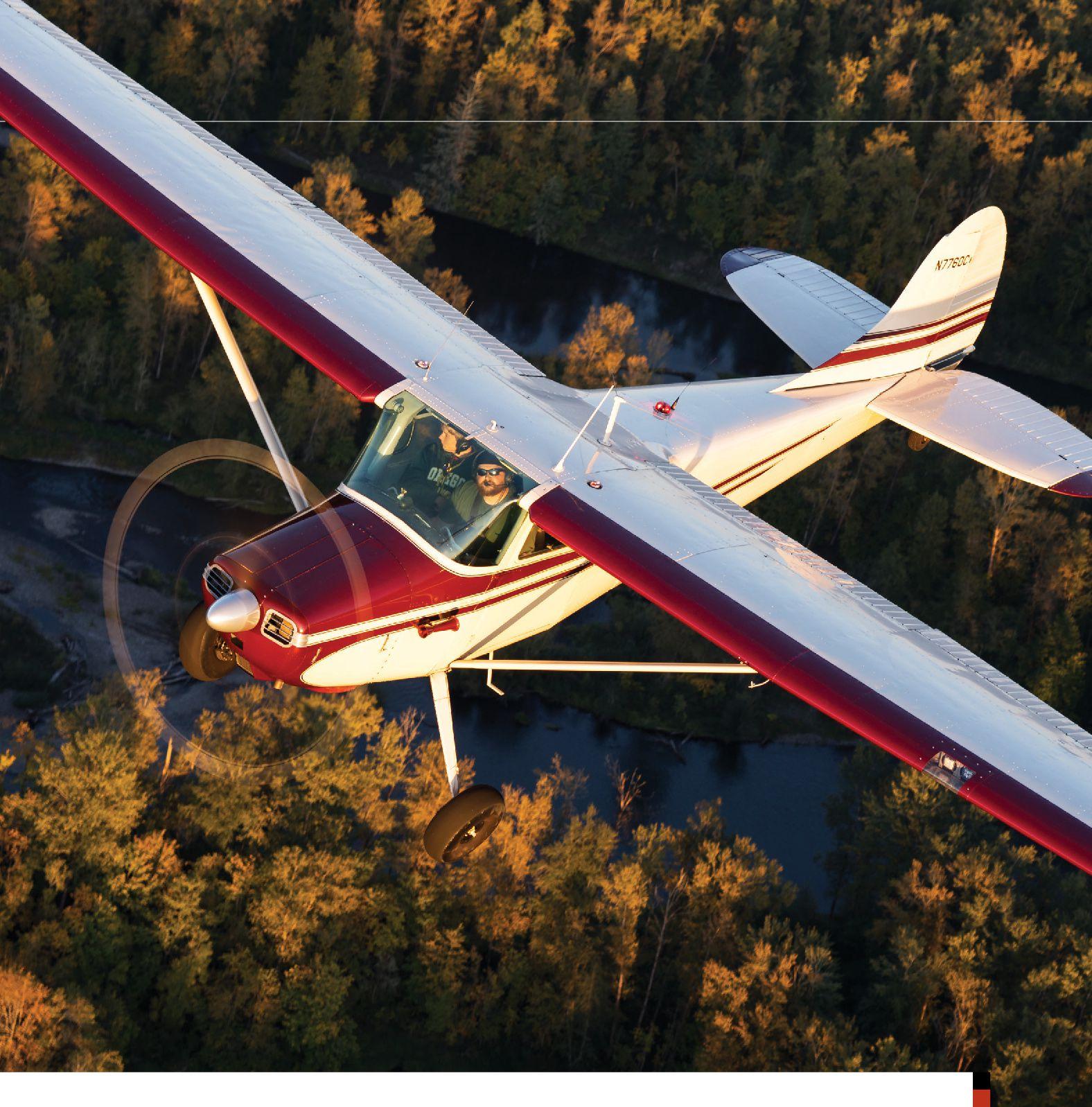MEMORY LANE
KEEPING IT ORIGINAL CLASSY 170


MEMORY LANE
KEEPING IT ORIGINAL CLASSY 170

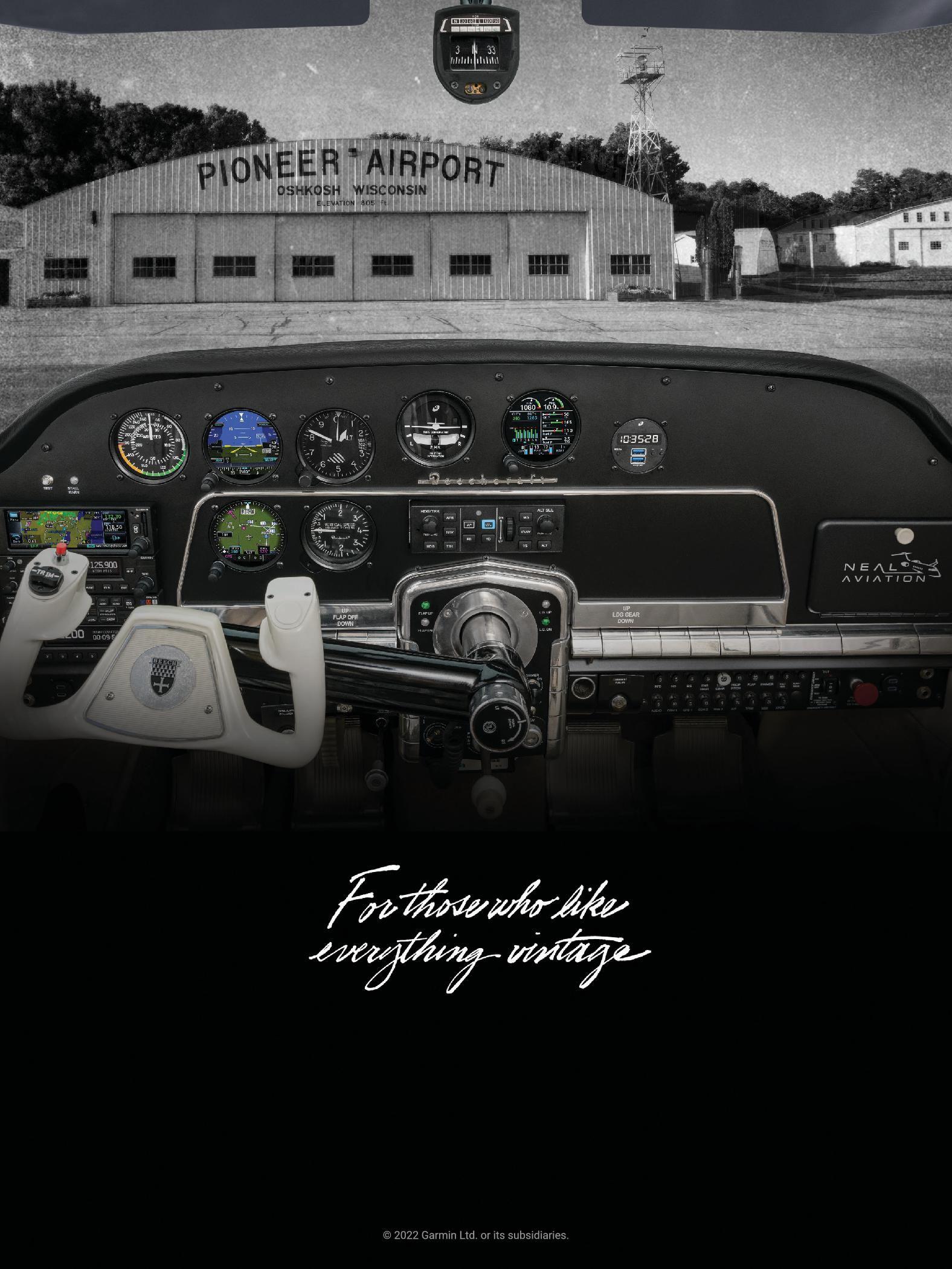
THE COUNTDOWN FOR EAA AIRVENTURE Oshkosh 2023 has begun, and those of us behind the scenes feel the push and have upped our game! Attractions in the Vintage area are rapidly developing. AirVenture 2023 is shaping up to be an extraordinary year with some truly remarkable airplanes and programs. At this point, AirVenture Oshkosh is full of promise and excitement for all of you to enjoy!
Headlining this year’s programs in the Vintage area is the Cessna 170 Vintage Reunion.
As a big fan of the Cessna 170, I am so pleased that we are recognizing this solid and iconic airplane. Back in the late 1940s, the market was saturated with two-place airplanes. Cessna 120s/140s, Piper Cubs, Taylorcrafts, Swifts, Culvers, Interstate Cadets, Porterfields, and others had flooded the market. Pilots were looking for an affordable four-place family airplane. Cessna Aircraft was already manufacturing the expensive Cessna 190/195 series, but that was an “executive” airplane. What it needed was an affordable familyoriented four-place airplane for pilots with moderate means. “Stretching” the 120/140 to make an affordable four-place family airplane was Cessna’s answer to this dilemma. The prototype Cessna 170 first flew in 1947 with production starting in 1948 under Type Certificate No. 799. Cessna went all out in the production of the 170 with the 1,000th 170 being delivered in May 1949.
My relationship with the 170 goes back to early in my flying career as I trained in and took my instrument checkride in a 170. I was a student at Winthrop College (now Winthrop University) at the time, and my instructor (and owner of the 170) was Dr. Ben Lampton, who was then a professor in the math department at Winthrop. We flew out of Ben’s private airport that was located on his farm in upstate South Carolina. What I do remember about that particular checkride was that the winds were howling, and I had one heck of a time getting to the runway for takeoff, as the 170 kept wanting to weathervane with me. Anyway, I made it through the taxi and the gusty flying conditions and passed that memorable checkride in the 170.
Over the years, I have continued to get some flight time in 170s, but in today’s world, I find myself performing 170 maintenance instead of flying one. Fellow retired ABX Air pilot and friend Walt Weaver from Concord, North Carolina, owns an early 1952 Cessna 170B with a Continental O-300 engine with the original piano key switches. For years, I have been conducting Walt’s annual inspection. (Walt assists me on these annuals, as he is a certificated FAA A&P mechanic; I hold an A&P certificate with an inspection authorization.) Anyway, I am constantly comparing Walt’s 170 to my 180.
March/April 2023
STAFF
Publisher: Jack J Pelton, EAA CEO and Chairman of the Board
Vice President of Publications, Marketing, Membership
and Retail/Editor: Jim Busha / jbusha@eaa org
Senior Copy Editor: Colleen Walsh
Copy Editors: Tom Breuer, Jennifer Knaack
Proofreader: Tara Bann
Print Production Team Lead: Marie Rayome-Gill
Advertising Manager: Sue Anderson / sanderson@eaa.org
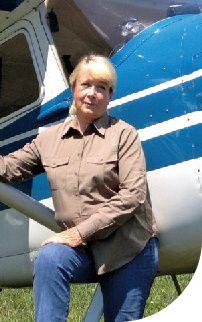
Mailing Address: VAA, PO Box 3086, Oshkosh, WI 54903
Website: EAAVintage org
Email: vintageaircraft@eaa org
Phone: 800-564-6322
Visit EAAVintage org for the latest in information and news
Current EAA members may join the Vintage Aircraft Association and receive Vintage Airplane magazine for an additional $45/year
EAA membership, Vintage Airplane magazine, and one-year membership in the EAA Vintage Aircraft Association are available for $55 per year (Sport Aviation magazine not included). (Add $7 for International Postage.)
Foreign Memberships
Please submit your remittance with a check or draft drawn on a United States bank payable in United States dollars Add required foreign postage amount for each membership
Membership Service
P O Box 3086, Oshkosh, WI 54903-3086
Monday–Friday, 8 AM 6 PM CST
Join/Renew 800-564-6322
membership@eaa.org
EAA AirVenture Oshkosh
www EAA org/AirVenture 888-322-4636
Headlining this year’s programs in the Vintage area is the Cessna 170 Vintage Reunion.
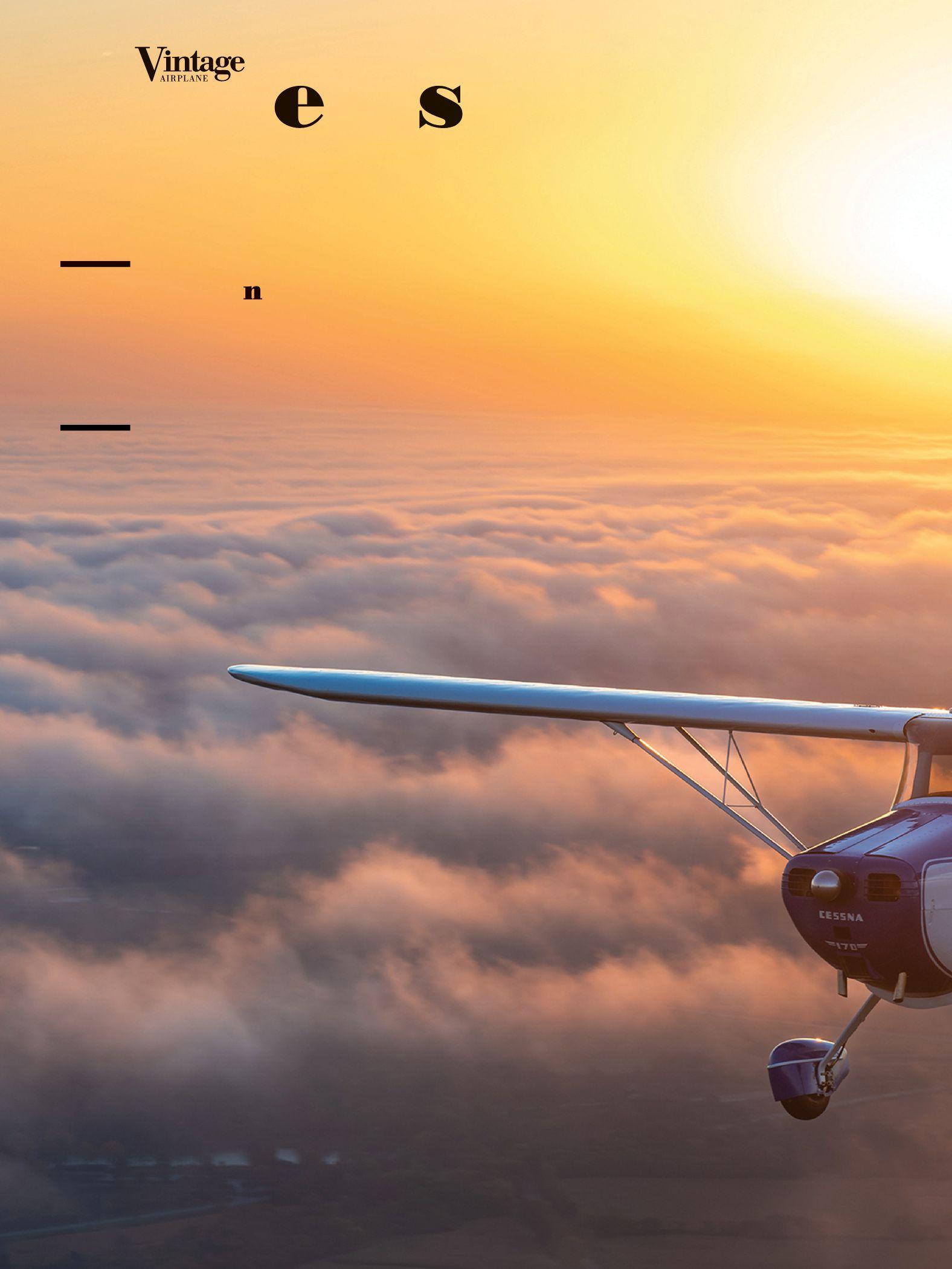







Nominate your favorite vintage aviator for the EAA Vintage Aircraft Association Hall of Fame. A great honor could be bestowed upon that man or woman working next to you on your airplane, sitting next to you in the chapter meeting, or walking next to you at EAA AirVenture Oshkosh. Think about the people in your circle of aviation friends: the mechanic, historian, photographer, or pilot who has shared innumerable tips with you and with many others. They could be the next VAA Hall of Fame inductee — but only if they are nominated.
The person you nominate can be a citizen of any country and may be living or deceased; his or her involvement in vintage aviation must have occurred between 1950 and
the present day. His or her contribution can be in the areas of flying, design, mechanical or aerodynamic developments, administration, writing, some other vital and relevant field, or any combination of fields that support aviation. The person you nominate must be or have been a member of the Vintage Aircraft Association or the Antique/Classic Division of EAA, and preference is given to those whose actions have contributed to the VAA in some way, perhaps as a volunteer, a restorer who shares his expertise with others, a writer, a photographer, or a pilot sharing stories, preserving aviation history, and encouraging new pilots and enthusiasts.
To nominate someone is easy. It just takes a little time and a little reminiscing on your part.
• Think of a person; think of his or her contributions to vintage aviation.
• Write those contributions in the various categories of the nomination form.
• Write a simple letter highlighting these attributes and contributions. Make copies of newspaper or magazine articles that may substantiate your view.
• If at all possible, have another individual (or more) complete a form or write a letter about this person, confirming why the person is a good candidate for induction.
We would like to take this opportunity to mention that if you have nominated someone for the VAA Hall of Fame, nominations for the honor are kept on file for three years, after which the nomination must be resubmitted.
Mail nominating materials to: VAA Hall of Fame, c/o Amy Lemke
VAA
PO Box 3086
Oshkosh, WI 54903
Email: alemke@eaa.org
Find the nomination form at EAAVintage.org, or call the VAA office for a copy (920-426-6110), or on your own sheet of paper, simply include the following information:
• Date submitted.
• Name of person nominated.
• Address and phone number of nominee.
• Email address of nominee.
• Date of birth of nominee. If deceased, date of death.
• Name and relationship of nominee’s closest living relative.
• Address and phone of nominee’s closest living relative.
• VAA and EAA number, if known. (Nominee must have been or is a VAA member.)
• Time span (dates) of the nominee’s contributions to vintage aviation. (Must be between 1950 to present day.)
• Area(s) of contributions to aviation.
• Describe the event(s) or nature of activities the nominee has undertaken in aviation to be worthy of induction into the VAA Hall of Fame.
• Describe achievements the nominee has made in other related fields in aviation.
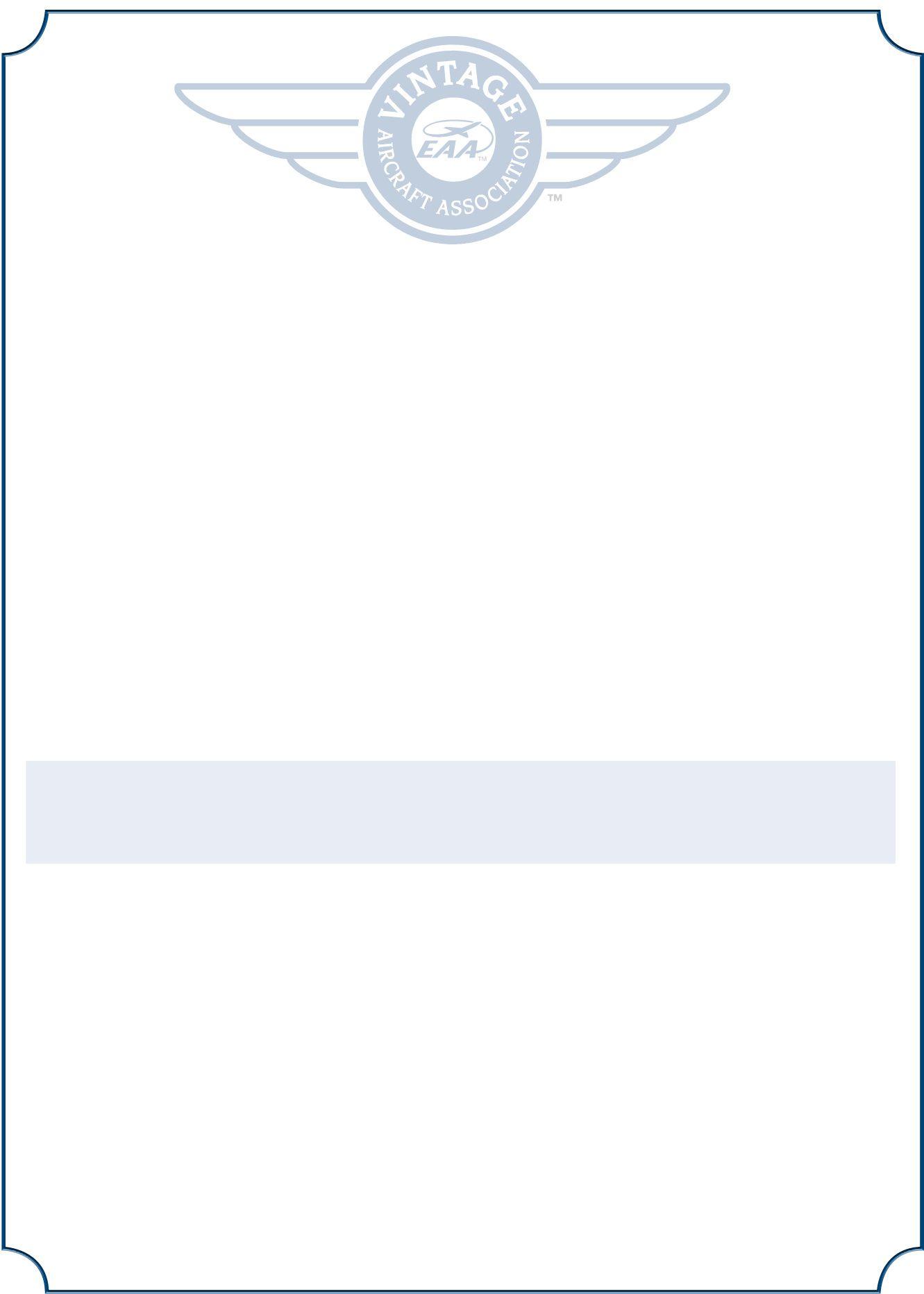
• Has the nominee already been honored for his or her involvement in aviation and/or the contribution you are stating in this petition? If yes, please explain the nature of the honor and/or award the nominee has received.
• Any additional supporting information.
• Submitter’s address and phone number, plus email address.
• Include any supporting material with your petition.
For one week every year a temporary city of about 50,000 people is created in Oshkosh, Wisconsin, on the grounds of Wittman Regional Airport. We call the temporary city EAA AirVenture Oshkosh. During this one week, EAA and our communities, including the Vintage Aircraft Association, host more than 600,000 pilots and aviation enthusiasts along with their families and friends.
As a dedicated member of the Vintage Aircraft Association, you most certainly understand the impact of the programs supported by Vintage and hosted at Vintage Village and along the Vintage flightline during EAA AirVenture Oshkosh every year. The Vintage flightline is 1.3 miles long and is annually filled with more than 1,100 magnificent vintage airplanes. At the very heart of the Vintage experience at AirVenture is Vintage Village and our flagship building, the Red Barn.
Vintage Village, and in particular the Red Barn, is a charming place at Wittman Regional Airport during AirVenture. It is a destination where friends old and new meet for those great times we are so familiar with in our close world of vintage aviation. It’s energizing and relaxing at the same time. It’s our own field of dreams!
The Vintage area is the fun place to be. There is no place like it at AirVenture. Where else could someone get such a close look at some of the most magnificent and rare vintage airplanes on Earth? That is just astounding when you think about it. It is on the Vintage flightline where you can admire the one and only remaining lowwing Stinson Tri-Motor, the only two restored and flying Howard 500s, and one of the few airworthy Stinson SR-5s in existence. And then there is the “fun and affordable” aircraft display, not only in front of the Red Barn but along the entire Vintage flightline. Fun and affordable says it all. That’s where you can get the greatest “bang for your buck” in our world of vintage airplanes!
For us to continue to support this wonderful place, we ask you to assist us with a financial contribution to the Friends of the Red Barn. For the Vintage Aircraft Association, this is the only major annual fundraiser and it is vital to keeping the Vintage field of dreams alive and vibrant. We cannot do it without your support.
Your personal contribution plays an indispensable and significant role in providing the best experience possible for every visitor to Vintage during AirVenture. Contribute online at EAAVintage.org. Or, you may make your check payable to the Friends of the Red Barn and mail to Friends of the Red Barn, PO Box 3086, Oshkosh, WI 54903-3086.
Be a Friend of the Red Barn this year! The Vintage Aircraft Association is a nonprofit 501(c)(3), so your contribution to this fund is tax deductible to the extent allowed by law.
Looking forward to a great AirVenture 2023!
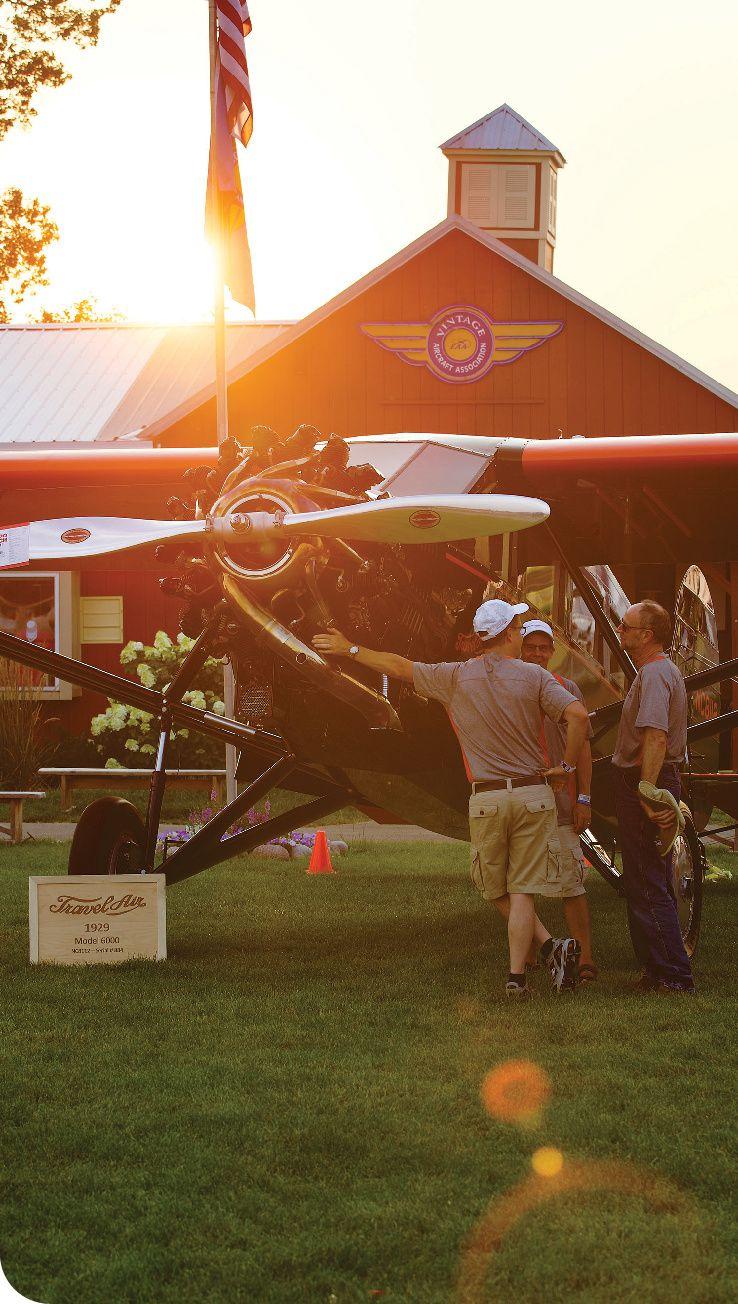
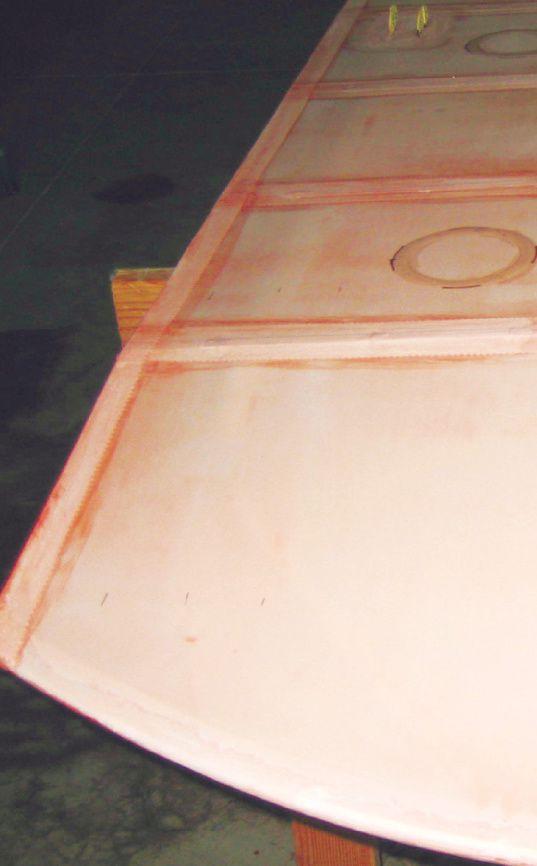

WOVEN POLYESTER FABRIC TENDS to unravel when it is cut dry, and the gluing process can be a real pain with threads and filaments pulling from the cut. To avoid this problem I use a process that coats the cut line with the first coat of filler material (in this case Poly-Brush), allowing it to dry, and then cutting with a good pair of scissors, razor blade, or knife. It works
 Figure
Figure
well and gives a nice straight line with no fraying of the fibers. See Figure 1.
Figure 2 shows a left-hand Hatz biplane upper wing being covered with the Poly Fiber process. I always lap the seams where they won’t easily be seen; therefore, the final overlap on the upper wings is on the top, and on the lower wings it’s on the bottom. Install the top fabric first and securely bond it to the structure. When the glue dries, gently preshrink the fabric enough to remove any wrinkles from the leading and trailing edge. Then brush a strip of Poly Brush about 2 inches wide where the lower fabric will be attached. When this is dry, begin to attach the lower fabric, wrapping around the leading edge, and then mark the cut lines with a pencil and use a long straight edge. Brush a coat of Poly Brush along the pencil line and allow it to dry. Then, place a clean 1-by-4-inch wood strip under the cut line and, using the long straight edge, razor cut the line. The wingtip can be done in the same manner, only you will have to heat shrink the fabric around the wing bow to avoid wrinkles. Once the fabric is heat shrunk around the bow, mark it with a pencil, brush on a coat of Poly Brush, and let it dry. Then make the cut with a pair of sharp scissors, starting the cut and then pushing the scissors to make the cut. Once the lap joints have cured, the fabric may be heat shrunk per instructions of the manufacturer.
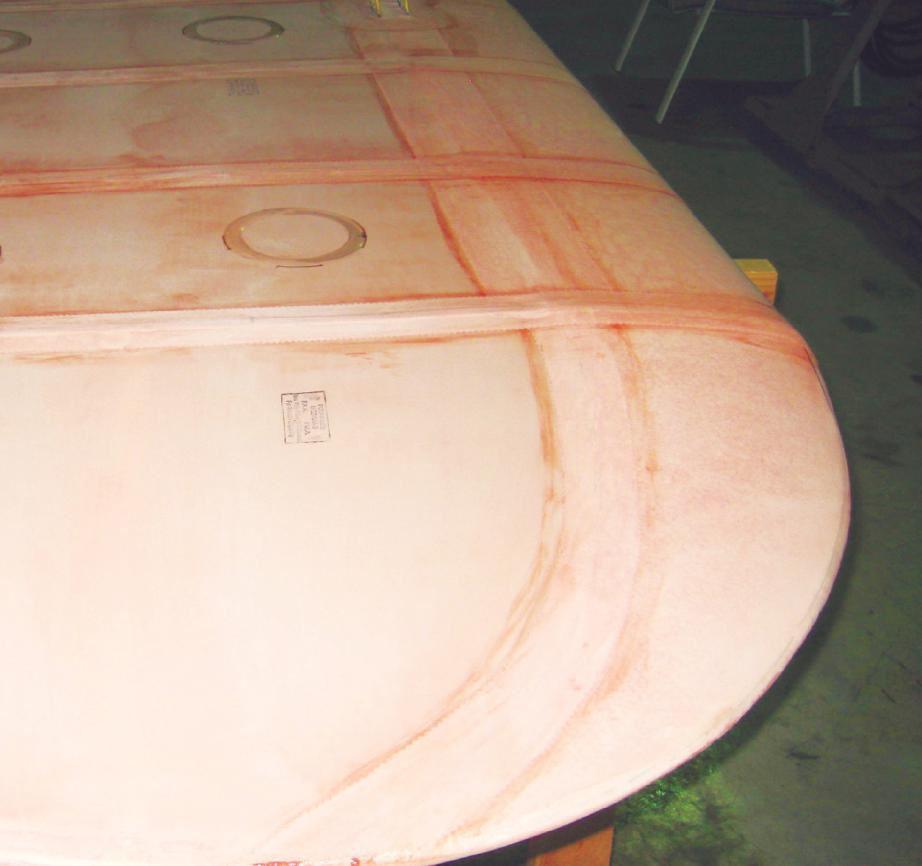
and grime, deoxidize, enhance paint gloss and provide a protective UV barrier. Increasingly popular, particularly since the elimination of water makes scheduling exterior cleaning flexible and convenient. DryWash can be adapted to surfaces by the extent, condition and type of soil. Its targeted surface application addresses signs of wear, corrosion and metal fatigue, all required checks for safety compliance. A well-designed DryWash system deep cleans irregular surfaces, depositing a barrier against paint deterioration and inhibiting further oxidation, soiling and stains. The protective coating guards against UV and other atmospheric degradation, while reconditioning the surface, enhancing gloss appearance and intensifying paint color.
DryWash technology is the perfect solution to growing concerns of sustainable water management. Wastewater and runoff from wet wash pits cause very real problems with groundwater and soil contamination. This waterless application deftly addresses concerns for conservation and environmental compliance.
NUVITE offers a high-quality line of DryWash productsNuPol®, NuPower II®, NuGlaze® and CitriCut® Xtra. All engineered to clean, condition, protect, enhance and improve the longevity of your aircraft’s appearance, each has attributes to meet specific surface conditions.

Ceramic-based coatings are pricey as they require skillful application and follow up maintenance to meet longevity claims. NUVITE has another option...NuGlaze® Paint Sealant and Polish. Not technically a coating, but a chemical sealant that checks many of the same boxes. NuGlaze® locks out moisture, fights oxidation, repels bugs/soil, enhances color and extends shine. Application is easy and can be done anywhere - just APPLY, DRY, BUFF to high-gloss shine. target area, no more than 24sq inches. Running app. 1000 rpms, move up and down,lefttorightinacrosshatchpattern until the target area is fully polished.
burntheclearcoatorcutrightthroughthepaint.Forpainted surfaces it’s better to hold the random orbital flat against
Full NUVITE Product Line Available at:
To Order: 877.477.7823 aircraftspruce.com
DryWash, a waterless deep cleaning technology, uses a chemical formula to remove soil ®
QUESTIONS? Contact our technical specialists with unique requirements or for product and equipment recommendations. 516.935.4000


G s

F what was ...


 BY SCOTT BENGTSON
BY SCOTT BENGTSON
THE POSTWAR YEARS OF World War II saw an influx of new aircraft and new aircraft companies. In Wichita, Beech went back into production with its prewar Model 18 and Staggerwing Model 17, and introduced us to another Wichita product that became aviation history, the Bonanza.
A little and not as well-known manufacturer, Culver, had secretly produced target drones for the war effort in north Wichita and had been led by a couple of brothers named Mooney, who also had some postwar ideas about building airplanes. The Boeing plant in Wichita had produced thousands of Stearman trainers and B-29s, and remained in military production after the war, later producing B-47s and B-52s.
While Cessna had been successful with the Airmaster and produced thousands of multiengine trainers based off the T-50 Bobcat, a manager at Cessna, Dwayne Wallace, said it was

done with tube and wood aircraft and would move forward with formed aluminum offerings.
At Cessna, things were humming along with the development of the 190/195 providing a high-performance aircraft and the 120/140 training the GIs who came back from the war through the GI Bill. The development timelines of Cessna’s products were very close together and share many of the same design elements. Model 140 received its Civil Aeronautics Administration approval just months ahead of the 195, and production was in full swing for both models. The 140 was such a success, and Cessna produced 22 units per day in August 1946. This would not have been possible with a welded fuselage and wood.

This success with trainers and high-performance models made it clear that a new need was emerging. Businessmen who had trained in the 140 needed an economical but familiar airplane to expand their business. Work was started on what was to be the 170. Cessna identified the niche, but what would they fill it with? What would the price be that would allow this businessman to buy and operate it? And what could he expect in performance for those dollars? What was available in technology and materials? And to make it fully functional, it would need to be IFR-capable. What is available from its own playbook of the 140 and 195? What does the competition have that Cessna would need to make sure it was better at, and what can it do that hasn’t been done? All the answers to these questions were needed and rolled up into how soon it could get to market.
As the group of engineers and management set out on the 170 development, could these men have dreamed that what they were doing would be the nucleus of what was to be Cessna? That their design was the beginning of the most produced aircraft of all time, making Cessna the most prolific general aviation aircraft manufacturer of all time?
How did they get there? To support the timeline, the wing development was simply increased in span versus the existing 140 wing panel. The wing panel of the 140 was not changed; lengthening the spars by 36 inches on both sides provided the basic 170 wingspan that would serve Cessna for many models to come. The fuel tanks came from the 140, and like the 140, the 170 would have fabric-covered wings so the tanks had to be self-contained, but two were placed in the right
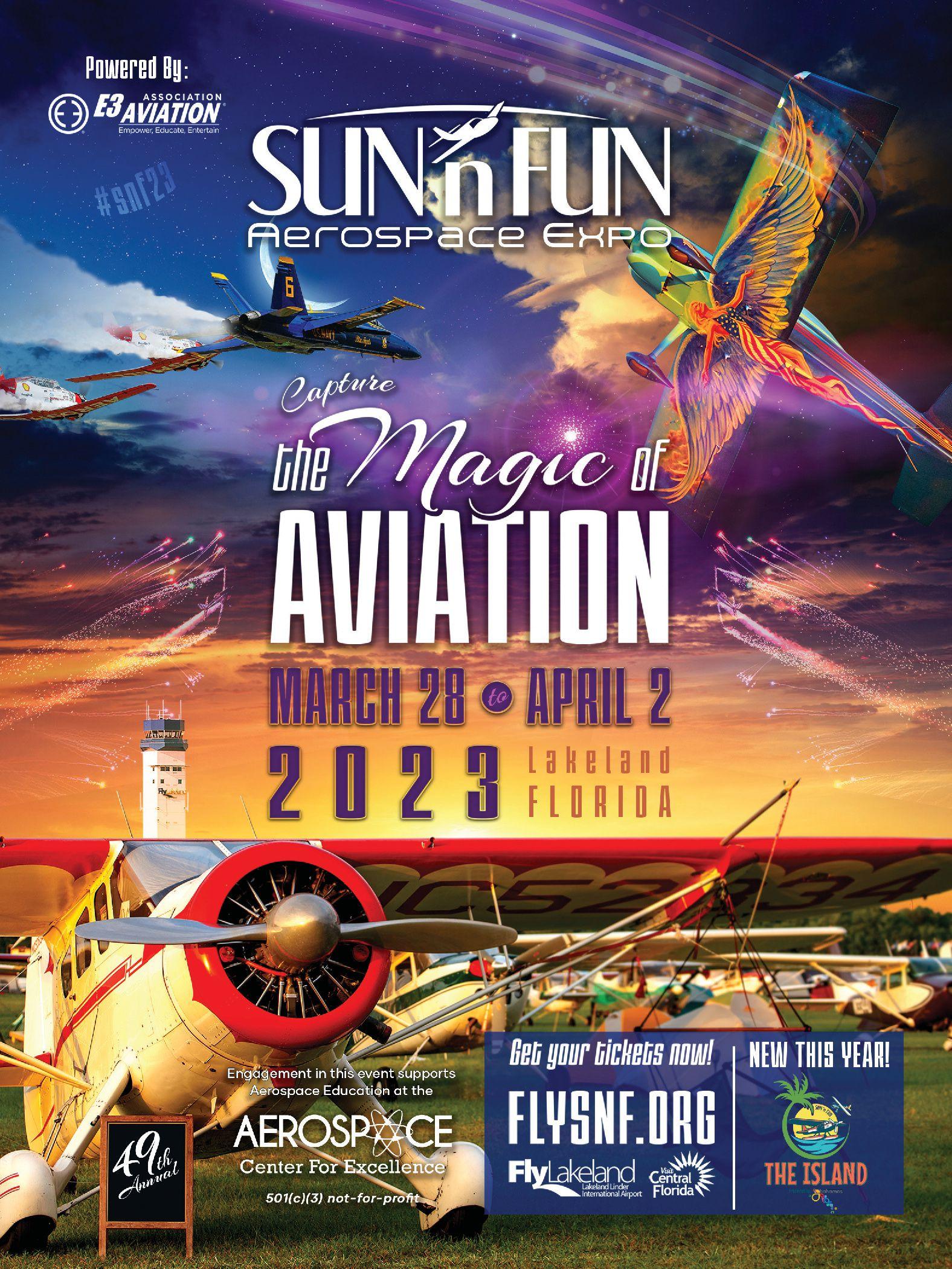
wing to provide the range expected of the 170 with the additional horsepower.
The ailerons remained the same as the 140, which left some concern about roll rates of the larger aircraft. Flaps from the 140 were extended inboard the additional length of the wing. Longer V-braced wing struts were developed to support the additional span. With the same 2412 airfoil and planform of the 140, the 170’s flight characteristics were expected to be similar.


Four places created a need for a large center-of-gravity range. A powerful elevator would be needed. The engineers
went to the shelf; except for some installation details, the 170 horizontal and vertical stabilizers came from the 190/195.
Another detail that was borrowed from the 140 was the landing gear spring. It is the same part number for both the 140 and the 170, even though the 170 has a 750-pound-higher gross weight than the 140. The landing gear was considered conventional at the time, which meant it was a taildragger; it would be a decade before the tricycle gear was introduced in the Cessna line.
There are many other detailed parts from both the 190/195 and the 140 all through the 170. This not only sped up development, but also saved a great deal of time and money on tooling
The fuselage design was new but shared the same long, tapering shape of the 140 Cabin space would be important for the second row of passengers if this were to be a business aircraft
Cessna acquired a Stinson 108 during the development of the 170, and cabin comfort was one of the attributes that had to be better than the Stinson. By comparison, the 170 turned out much roomier than the Stinson. This additional length additional created some challenges, with the 170 needing a large CG range. This requirement also supported using the 190/195 horizontal tail assembly, in addition to the existing design expediting the development

The powerplant for the 170 was the six-cylinder Continental C145; as in the name, 145 hp is
what it put out. This engine was used throughout the entire 170 model production run. In 1958, it started being referred to as the O-300, in reference to displacement, but still provided the same 145 hp
The structural design of the aircraft was also similar to the 140 The fuselage is made of formed skins with flanged horizontal edges stiffening the assembly, minimizing the need for individual stringers Bulkheads share the same fuselage station, as the ends of the formed sheet metal skins created a lightweight tail cone assembly
Most of the systems in the 170 followed the philosophy of the 140. Flight controls were all cables and pulleys, as were both pilot and co-pilot control wheels. The plain flaps traveled 30 degrees and were controlled by a floor-mounted lever between the pilot seats. The fuel system was gravity fed, with fuel stored in metal tanks in each wing. This made for a simple system, which did not require any pumps, and a simple fuel selector valve Fuel quantity was shown on an
As the group of engineers and management set out on the 170 development, could these men have dreamed that what they were doing would be the nucleus of what was to be Cessna?
indicator connected to a float in the fuel tank in the wing root; this indicator also came from the 140.
Braking was a hydraulic system using toe brakes attached to a master cylinder linked to each of the pilot’s rudder pedals; at the wheel, a disc-type brake was used. An optional crosswind landing gear was available; this allowed the airplane to weather vane for wind conditions and still track straight down the runway. This need was possibly a sign of what the future would bring.
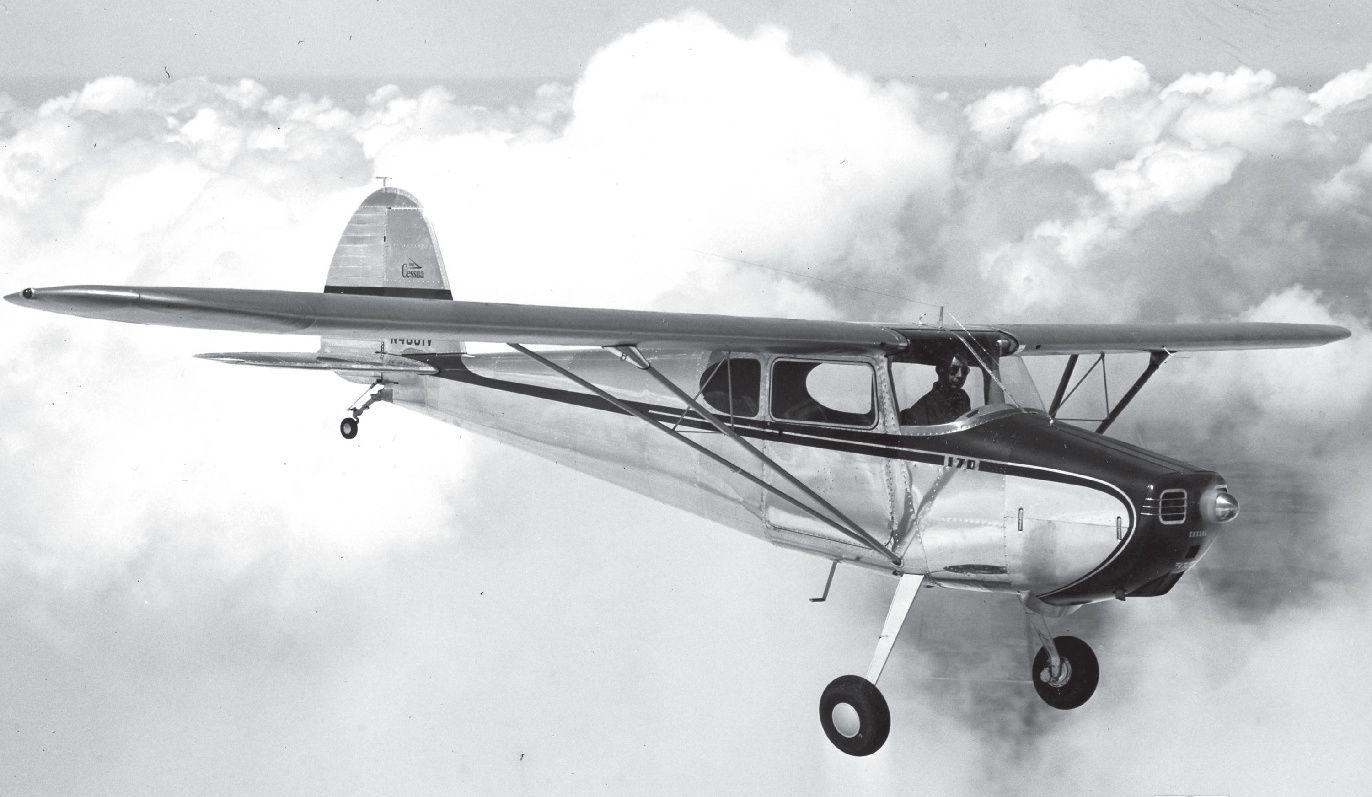
The 170 was an all-aluminum airplane except for the steel spring landing gear, engine, engine mount, and fabric-covered wings, although that would change with subsequent models. This method of construction using formed sheet metal allowed for the high production rates that would be needed to produce the quantities the market demanded. Cessna had years of experience with steel tube, wood, and fabric and recognized that those materials would
not allow for the production rates it had planned or for the modern aircraft of the future. The complex shapes and lines of these aircraft demanded the need for formed aluminum, and it proved to be far superior. History has demonstrated this in many aircraft manufacturers’ product lines; there were no successful mass-produced tube and fabric aircraft in the postwar era. The construction methods of the early 100-series Cessnas are still used today in the production of the current Cessna models.
Cessna rolled out the first prototype of the new design in nine months, in November 1947. A second prototype joined just a month later, and a third in the following April. First flight came on November 5, 1947. Flight testing proved smooth for the 170. Minor changes were made through the development, like changing the angle of incidence on the horizontal stabilizer to support full-flap, forward CG power-off landings. By all accounts, the handling was good from the beginning, and a lot of the test flying was associated with performance involving oil cooling and propeller performance. CAA certification came June 1, 1948, followed by the utility category certification on July 12 of the same year. The utility category allowed for maneuvers not approved in the standard category, some of which were needed for commercial training.

The prototypes for the 170 used production serial numbers. The first three aircraft were 18000, 18001, and 18002. When Cessna started using unique serials for the prototypes, they were three-digit numbers. The first model to do this was the Bird Dog 305 prototype, and it had a serial of 601.

Sales were strong, and production rates in 1948 of the 140, 195, and the new 170 stretched Cessna capacity A total of 730 170s were manufactured before the new 170A started production for the model year 1949 and was produced through 1951 In 1948, a revision to the 170 wing modified the outer panel from a constant chord to a tapered form, giving the wing a more graceful look that included a revised aileron. The new aileron had a leading edge different from the 170 that protruded into the airstream when the aileron was deflected and created a yaw inside the turn, reducing the amount of rudder needed during the turn This aileron became the standard configuration of the high-wing strutted aircraft that followed, and the same part number introduced into the 170A was used on the following 170 Model B and all variants of the 172 until a minor change was made in 2002 The same shape
was used on all models, such as the 180, 182, and 200 series, until the deep chord ailerons were first introduced in 1964 on the 200 series except additional balance weight was required because of the higher speeds of those models.
This new shape did several things for the 170A. It provided a new, sleeker look along the single wing strut that came with the tapered wing, a result of the higher strength strength from the new metalized wings replacing the fabric cover Other improvements to the wing included new fuel tanks replacing the 140 tanks, with one in each wing holding 21 gallons The flap travel increased to 50 degrees from the 30-degree flaps on the initial 170 A dorsal fin from the 195 was added, which improved yaw stability and distinguished it from the 140 at a glance
The manufacturing benefit came from the reduced production time involved with the dope and fabric process of the 170. This new 170A outer panel design was driven into the 140 model, creating the famous 140A using the same part numbers as the 170A, including the new aileron. Again this benefited production, reducing the process of covering the wings and eliminating the dangers associated with the doping process
As the 170 was a benefactor of the 140 and 195, the 170 lent its design to a new Cessna developed for the Army Cessna became interested in the Army’s need for a liaison aircraft that had some aggressive takeoff performance
Cessna used a part numbering system that started with the 190 and is still in use today. The part number is from the drawing numbering system. The first two digits of the seven-digit part number is the model.
The 190/195 drawing numbers are 03XXXXX. Any parts beginning with “03” were developed for that model. If the same parts were used on other models, they maintain the original part number. So when you see a part number in the 170 parts manual that begins 03XXXXX, you know the original part was designed for use on the 190/195.
The 04XXXXX series is the 140/140A/150/152, followed by the 05XXXXX drawings that represent all of the 170/170A/170B/172. So when you look at the 170 parts manual, you will see part numbers beginning with 03, 04, and 05.
Often during the development of a new model, an improved part is developed that could apply to an earlier model, so it isn’t uncommon to see higher-model part numbers in an earlier aircraft. An early example of this is how the 140A wing incorporated several of the 170A part numbers to create the all-metal, single-strut wing. Subsequent to this, the following models will have 170 series parts in them, such as the 180/182/185.
This continues today. The latest Citation still uses this number system. The part numbering system worked for all models; however, the twins and singles have very few parts in common due to the significant design differences of the two product lines.
The third digit of the drawing number defines the major section of the aircraft it pertains to. If the number is a zero, then it refers to the aircraft assembly. A 1 is for the fuselage, 2 is for the wing, 3 is the empennage, 4 is the landing gear, 5 is the engine installation, 6 is controls installation, 7 is electrical, 8 is general, and 9 is a modification drawing.
The fourth digit is dependent on the third digit it follows. As an example, if the third digit is 2, which is the wing, and the fourth digit behind the 2 is a 5, the drawing would be of flaps. So a part number 0525123 would mean it is a 170/172 series drawing involving the wing and specifically the flap.
The last three numbers are the sequence numbers of the drawing issuance. The dash number is a detailed part on the drawing or an assembly part number.
requirements, but the Army gave Cessna a short time to develop the aircraft. Cessna turned to the 170 and borrowed the wings and tail to mount onto a new fuselage design that gave the pilot 360 degrees of visibility. To meet the takeoff performance requirements, the 170A wing was modified with a new flap design that incorporated a slotted flap that moved aft and down, creating better lift than the simple hinged flap of the 170. The travel of the new flap was 60 degrees to provide the lift and drag needed for the Army takeoff and landing requirements. It was designated the 305 and known as the Bird Dog. Cessna won the contract and went on to produce almost 3,400 units. This would be the first variant of the 170.
As a direct result of the new flap design of the 305, the next model of the 170 would borrow from this new improvement. The slotted flap would be incorporated into the 170B. Different from the 305, the 170B would have a 40-degree flap travel in place of the 60 degrees of the 305. Another difference was the 170 had a clever flap track that didn’t have the exposed flap hinges of the 305. Marketing didn’t think the hinges hanging out of the wing were attractive, and also thought they were a nuisance for head injuries.
The 170B became the most produced of all the 170 series, starting in 1952 and finishing the model in 1956. Cessna was growing up. The influence of sales and marketing became evident in the 170B. It was marketed as the Businessliner, and the new flaps were referred to as Para-Lift; this was the start of many Cessna marketing names for features. Officially, the last model was in 1956; a few units were completed in 1957, mixed in with the new 172 production. Several improvements were made during the five years of production. Cessna models were evolving into refined transportation for business as well as pleasure.
The 170 almost had a fourth model, with what would have been the 170C. This model would have introduced the new empennage of the square tail design the industry was moving toward, replacing the elliptical shapes developed for the 195. The new design would have increased both the vertical and horizontal areas. The project completed certification but never went into production; instead there was pressure from rival Piper to compete with the Tri-Pacer, which was having success with a nose-mounted
gear. This simplified handling during takeoff and landings. Cessna embarked on a secret program to put a nose gear under the 170. They subsequently canceled the 170C program; however, the company retained the new tail configuration. tail The new program became the 172, and with that decision, Cessna was about to start the aircraft that would become the most produced aircraft of all time
The early Cessna engineers couldn’t have had any idea of what would become of their 170 design A refined version of the 170 was still the design being produced 75 years later. The planform, airfoil, flaps, and ailerons are virtually unchanged in the current 172S. All of the follow-on models 180, 182, 185, 188, 205, 206, 207, and the 210 through 210F use the planform of the 170. How many pilots learned to fly? How many miles have been covered by these wings? Cessna is still producing the 172, 182, and 206, adding more history-making aircraft and training more pilots
Many aircraft companies have come and gone, many using modern technologies to replace the single-engine Cessna. I think the original handful of engineers would be astonished at what they accomplished.

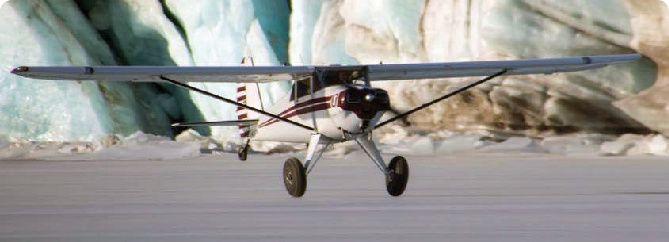
We have hundreds of quality FAA-PMA approved parts specifically for the Luscombe 8 series aircraft, plus distributor parts such as tires, tailwheels, and more.
Call us or visit our website to request your free Univair catalog. Foreign orders pay postage.
Toll Free Sales: 1-888-433-5433
Shop Online: www.univair.com
2500 Himalaya Road • Aurora, CO • 80011
Info Phone 303-375-8882
Fax ........800-457-7811 or 303-375-8888
Email info@univair com
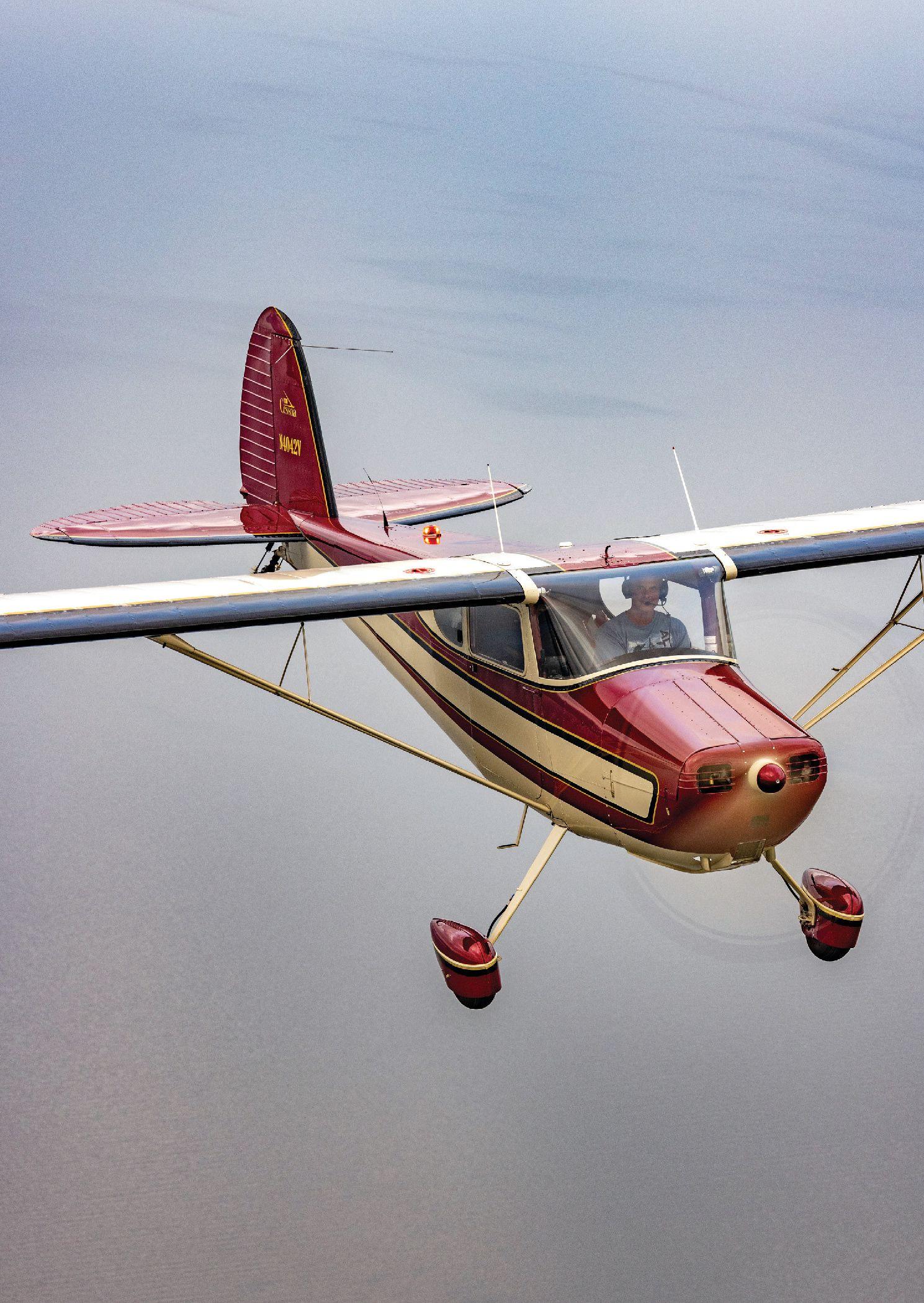
FROM A DISTANCE, IT’S easy to misidentify the original 170 Cessna for its baby cousin, the C-140. Or C-120. It has the same Hershey bar, fabric-covered wings, which are secured to the fuselage with V-struts. Plus, the vertical tail has the same rounded outline. This is not an accident.
The C-170 was born in the same time frame as the 120/140, by the same designers, and it’s worth putting into context both the airplane and its creators to understand the design evolution.
The Cessna 140 first flew in June 1945, and 120/140s were both certified in March 1946. At the time, Cessna was swept up in what turned out to be a legendary and massive market miscalculation made by the entire light aircraft industrial community. The “experts” all said that thousands of returning pilots would want their own airplanes. So, every manufacturer started churning them out. An amazing and oft-repeated fact from that period is that 1946 and ’47 saw an amazing 49,000 aircraft produced! The 140,



which was possibly the most sophisticated of the newer two-place, fixed-gear flivvers, was certified in March 1946. So, by the time it got into serious production later in the year, the race was on. Unfortunately, barely a year later, the writing was on the wall: Buyers were not lined up around the block, eager to soak up the massive number of aircraft being produced. In fact, many World War II pilots never flew again. The marketing experts were wrong. Very wrong.
The major manufacturers, Cessna and Piper being the numerical leaders, quickly saw that innovation, producing something new, aimed at setting their products apart from the crowd, was critical to their survival. That was what was going to give them a larger slice of what had become a rapidly shrinking pie. Piper went the direction of utilizing existing components from its Cub line and combined them in a number of short-wing fashions to produce lower-cost, two-place, rag and tube traditional airplanes. Cessna, which sensed that the all-aluminum 120/140s were seen as higher-quality products in the marketplace, decided to build on that base. Using the 120/140 concept as a foundation, they produced the 170, which was essentially a scaled-up, fourplace version of the original designs.
I had already purchased a Cherokee 180, but without hesitation bought this 170, if for no other reason because of whom it had belonged to.
— Bill Myers
al ason ong o.
The first 170 prototypes that flew in late February 1948 were 100 percent true to the 120/140 format: They had aluminum structure with fabric-covered, rounded-off Hershey bar wings, V-struts, Steve Wittman’s innovative spring steel landing gear, etc. Rushed into production, the original 170 was replaced by the 170A in 1949 after only 714 C-170s were built.
In production for barely a year, the basic 170 design was greatly modified in the 170A, which set the stage for what was to become the most-produced aircraft in the world, the 172 Skyhawk.
The 170A retained the aluminum fuselage and spring gear of the 170, but the rectangular fabric wings were replaced with all-aluminum, squared-off, tapered-tip wings that have been a Cessna staple since. Additionally, the dorsal fin from the round-engined Cessna 195 was added to the rounded vertical stabilizer, totally changing its appearance.
The 170B was introduced in 1952 and, along with it, the wildly effective slotted Fowler flaps that are now Cessna trademarks. Then, in 1955, when they put the nose wheel under the 170B and squared off the tail, the 170C was born. However, reportedly to keep the new airplane on the old type certificate, it was given a new, but similar, moniker,
“172.” Although 5,200 170s, 170As, and 170Bs were built, 44,000 172s were to follow.
“Skyhawk” was originally a trim package but became the breed’s official name in 1976.
With such a small number of early 170s built three-quarters of a century ago, it’s only logical that we see few of them. That’s why when Bill Myers, EAA Lifetime 538977, taxied into the Vintage area at EAA AirVenture Oshkosh 2021 in his 1948 170, more than a few observers were not sure what they were looking at. Did the attractive paint job make the 140 look bigger or what?
Without the dorsal fin introduced in the 170A, it can be confusing.
Bill, the owner of N4042V, was born and bred in rural Kansas and said he always wanted to learn to fly.
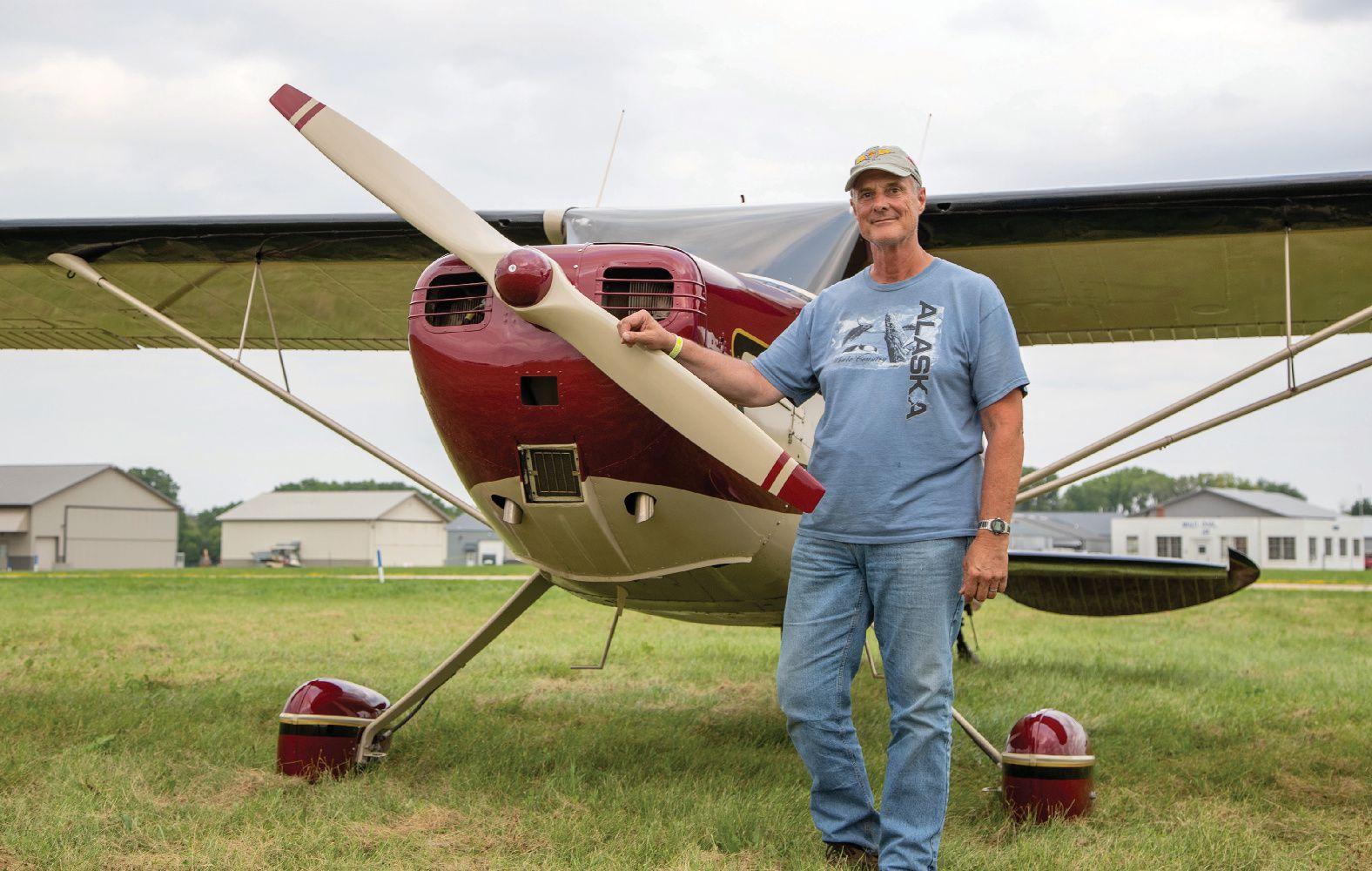
“Growing up in a small town, I never really had the opportunity or the finances,” he said.
“There were no pilots in the family, so I’m the first. I’m also the first doctor in the family, a foot surgeon, so working my way through college and medical school ate up all of my time and money.
Although Bill Myers owns other high-speed airplanes for cross-countries, Bill and his wife are often seen at fly-ins and pancake breakfasts in their 170. PHOTOGRAPHY BY JACK FLEETWOODBill said he never even gets in the airplane without remembering his instructor and the airplane’s last owner. So, a little of a young Joe McCosh goes on every flight with him.
In 1990, when my family and my practice were up and running, I finally decided to pull the trigger and take flying lessons. My flight instructor, Joe McCosh, was a recently minted CFI who had his own Cherokee 180 to give lessons in. He also owned a 1948 Cessna 170. We got along really well, even though his friends had warned him that it may be difficult to work with an older student and especially a doctor. Through the course of my instruction and getting my license, Joe and I became close friends. Sadly, three years later he was killed in a plane crash flying at night. They strongly suspect that it was carbon monoxide that brought the plane down in a field a long way from anywhere.”
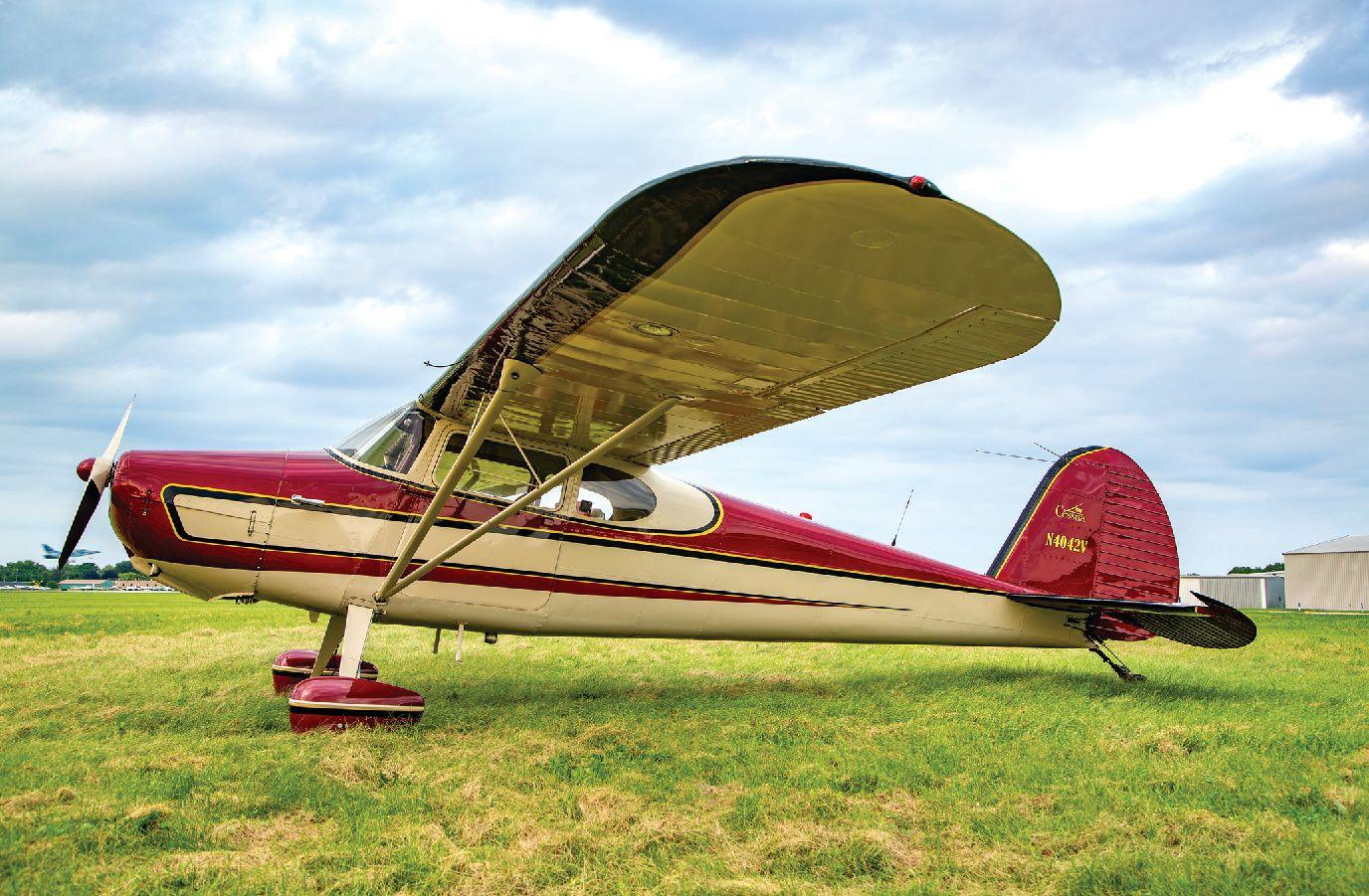
Bill stayed in touch with Joe’s family, and several years later Joe’s father asked if Bill would be interested in purchasing Joe’s 1948 170.
“It had been sitting in their hangar on a grass strip in the country since his death,” Bill said. “I had already purchased a Cherokee 180, but without hesitation bought this 170, if for no other reason because of whom it had belonged to. This is why I have such a sentimental attachment to the 170.”
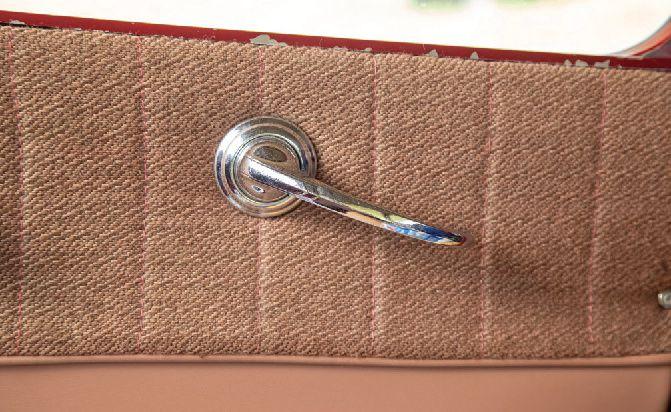
Because the airplane had been sitting for several years, Bill said some work was needed to get it airworthy.
“We brought it to town, and I immediately had the wings re-covered using Ceconite,” Bill said. “The inside of the wings were in amazingly good condition. That airplane had been hangared for most of his life, so all we did inside the wings was tweak a few ribs a bit. The aileron and flap corrugations were so good we didn’t have to touch them other than putting a very small patch on one flap.
“I flew it in its original state of polished silver with a red stripe for 10 or 12 years,” he said. “Polishing the aluminum was such a tedious job that I quickly got weary of trying to keep it looking good. It was then that I decided to go ahead and restore the airplane to its present condition.”
When someone restores a 70-year-old Cessna, the most common questions asked are, how much corrosion did you find, and how many skins had to be replaced? Are any of the corrugated control surface skins still original? To these, Bill had some surprising answers.


“All of the sheet metal was in much better condition than you would expect,” he said. “The bottom of the horizontal stabilizers and elevators showed the most wear because of multiple trips in and out of gravel roads in the country by previous owners. It was amazing working on the inside of the fuselage because the aluminum still shined all the way down to the tail.
“Marvin Hornbostel’s company, Raven Aero, in Junction City, Kansas, and his son, Jon, were the professionals whom I turned to for the restoration work,” Bill said. “They have been doing restorations on vintage airplanes for many, many years. Marvin is the recipient of the 2012 Aviation Maintenance Technician Award given to him at Oshkosh that year, as well as FAA’s Charles Taylor Master Mechanic Award.”
On the cowling, a new top cowl door was fabricated due to wind damage. The nose bowl, which is often beat up, was nearly perfect so little was done with it. Both the prop and engine were original to the airplane. The engine being a C145, which is the original version of the O-300A engine, is a six-cylinder Continental engine with 145 hp. The engine has about 450 hours since overhaul.
“I had a difficult time finding wheelpants for the aircraft, since the ones that turned up were in very poor condition and very expensive to boot,” Bill said. “I was told that with original wheelpants, they are very susceptible to dings and dents from people getting in and out of the aircraft. It was at that time I came across a small
company, Lahti Aerospace, who made vintage carbon fiber wheelpants for a very reasonable price. The detail was amazing, even to the rivet heads being visible. The best thing being carbon fiber is they were almost bulletproof.”
According to Bill, the instrument panel was in as good of shape as the rest of the airplane.

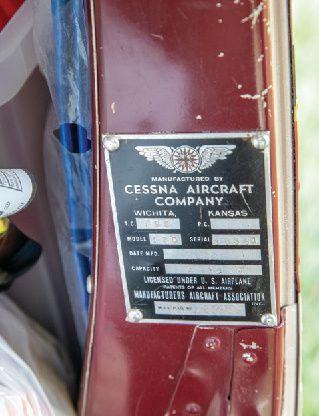
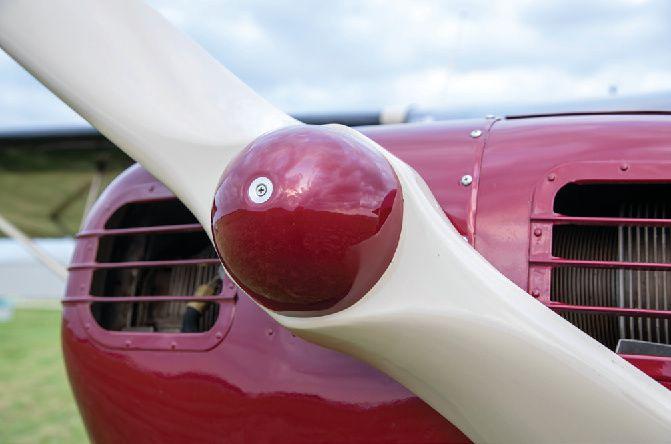
“At no point did anyone butcher it up trying to install newer radios or instruments,” he said. “In the early years, I had installed a first-generation Garmin GPS and comm radio in the lower left panel. Since this is a strictly VFR aircraft, I have found no need to upgrade this. The flight instruments are pretty much all vintage and original-looking. I had them refaced at one time to make them look nicer.
“I installed an Airtex carpet and had the side panels and seats redone by a local upholsterer in a vintage-looking fabric. I thought it turned out really nice. I just recently had Raven Aero put in a new headliner, since the old one had deteriorated.”
When it comes to painting an airplane, knowing that it’s the first thing people see and it’s something the owner has to live with, coming up with a scheme isn’t easy. It has been said that picking a paint scheme is like trying to name a child.
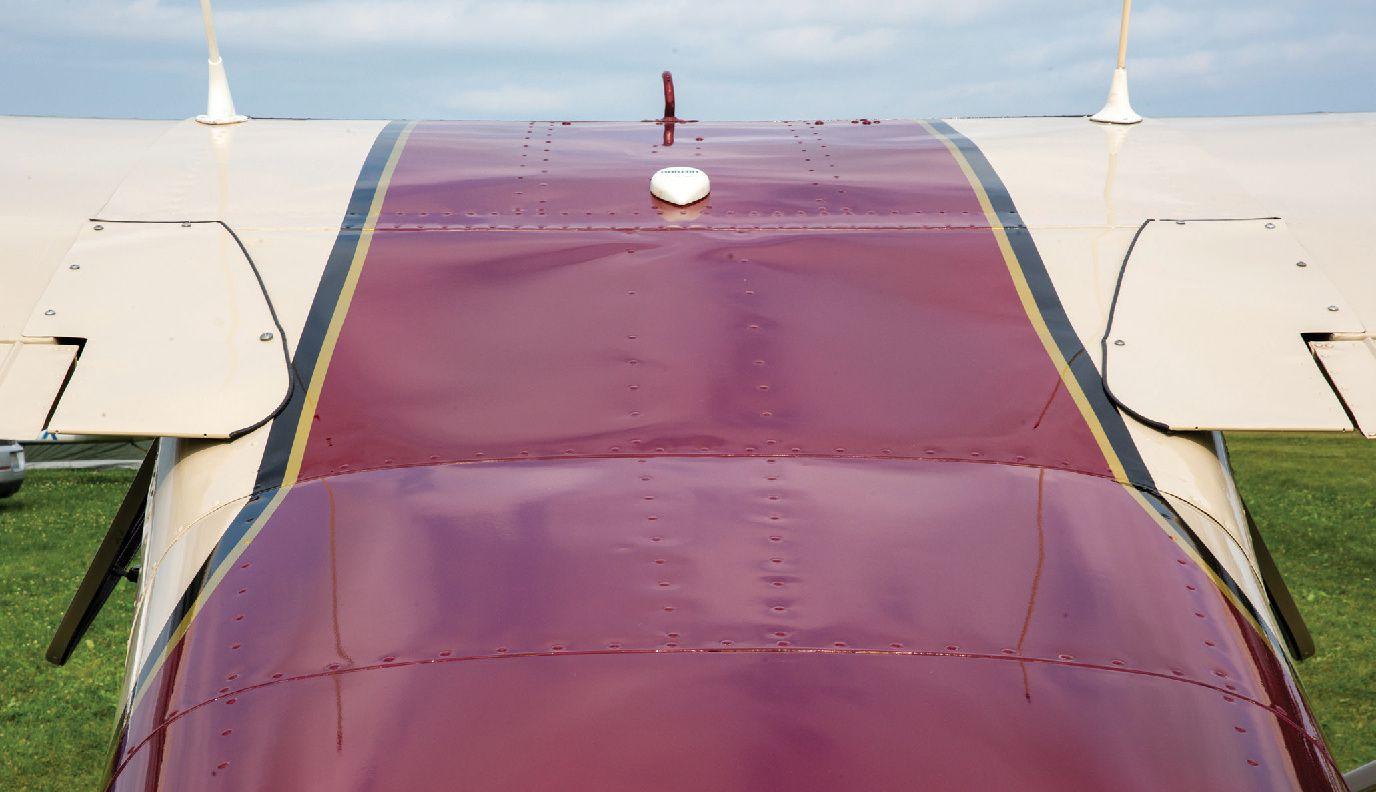 The sheet metal was so good, not a single panel was replaced.
The sheet metal was so good, not a single panel was replaced.
“Jon from Raven Aero helped me design a scheme that originally started from a vintage Cessna 180 and then was greatly modified after 20 to 25 versions,” Bill said. “The beige color is called Sandalwood. The gold and black are standard colors. The burgundy color is actually a General Motors color I saw on a neighbor’s new Buick and loved it. It all came together quite nicely.

“My wife, Del, and I have been flying the finished product for quite a few years now, and it never fails to elicit questions and comments from many folks at fly-ins and other airports we visit,” he added. “The summer of 2021 was the first time that I took it to Oshkosh and was able to park in the Vintage parking area.”

Bill has partnerships in a Piper Malibu and a Cessna 310Q and uses them for cross-country trips. He said he flies the 170 mostly to local fly-ins and pancake runs.
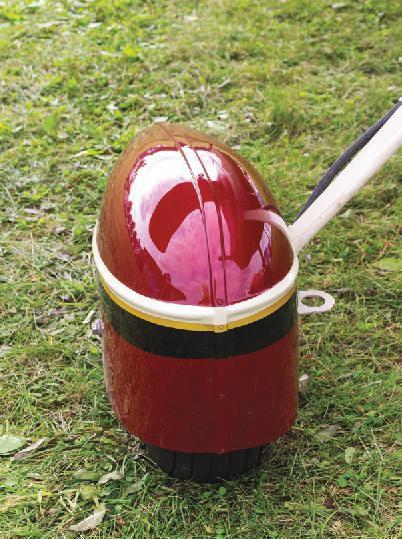


“When asked if there is anything I would do over again differently, I honestly have to say nothing,” he said. “I would consider putting a higher-horsepower Lycoming conversion in the aircraft when the C145 gives up the ghost. That’s about it.”
It’s nice when a relatively rare vintage survivor finds its way to an owner who uses the airplane and has a respect for its history. Bill said he never even gets in the airplane without remembering his instructor and the airplane’s last owner. So, a little of a young Joe McCosh goes on every flight with him.


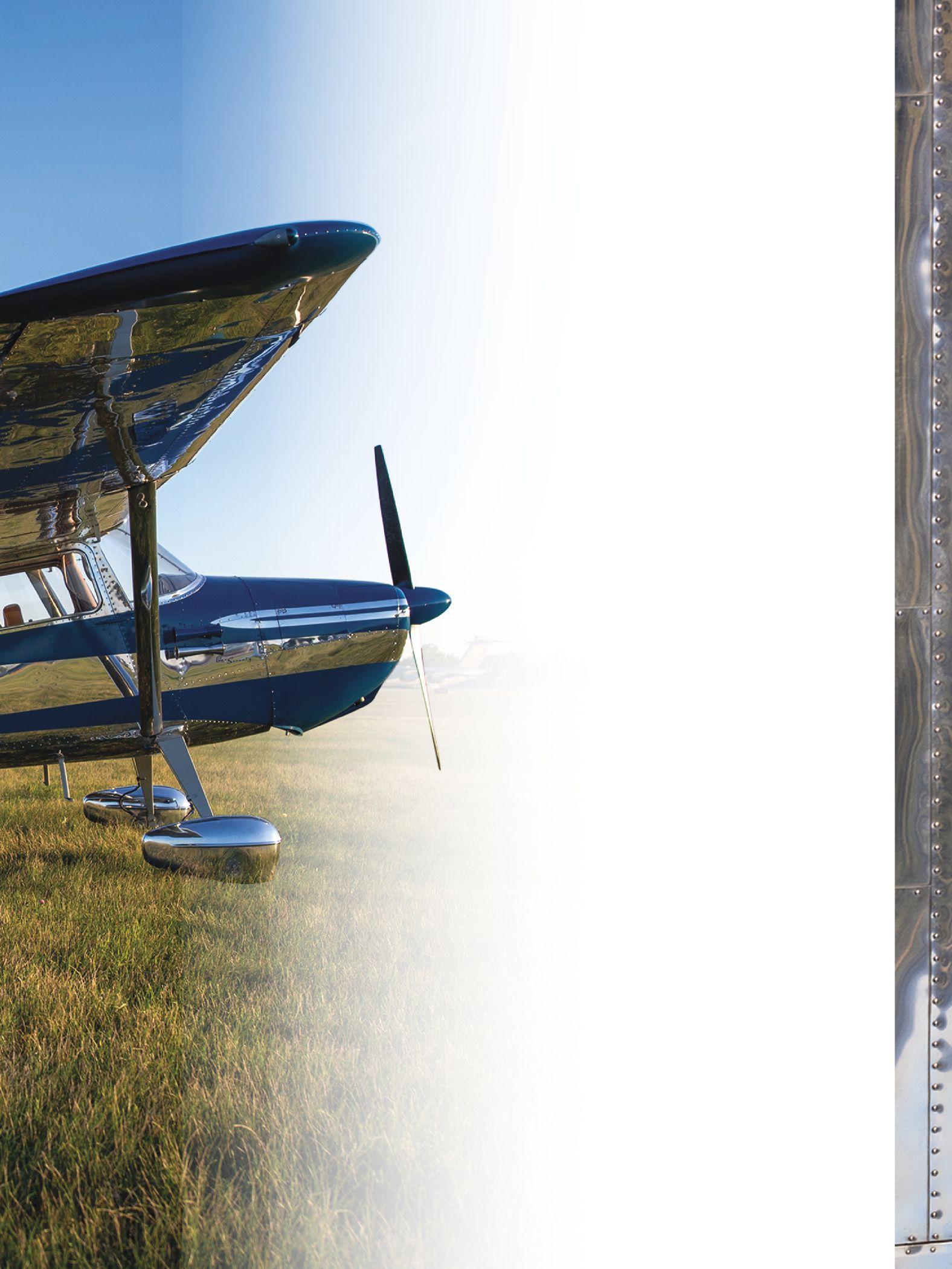 BY SPARKY BARNES
BY SPARKY BARNES
SEVENTY-FIVE YEARS AGO, THE Cessna Model 170 went into production at Cessna Aircraft Co. in Wichita, Kansas, and winged its way into the world of general aviation. Pilots were drawn to its aesthetic lines, ease of handling, and functional economy. Unbeknownst at that time, the 170 would be crowned with an aura of perennial popularity and would continue to reign in the kingdom of classic airplanes for the still-unforeseen future.
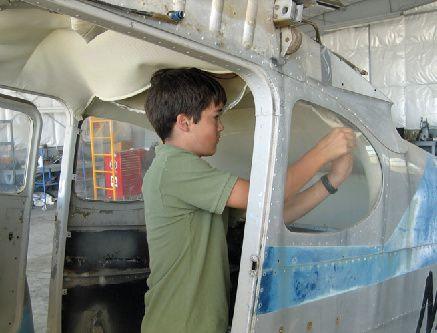


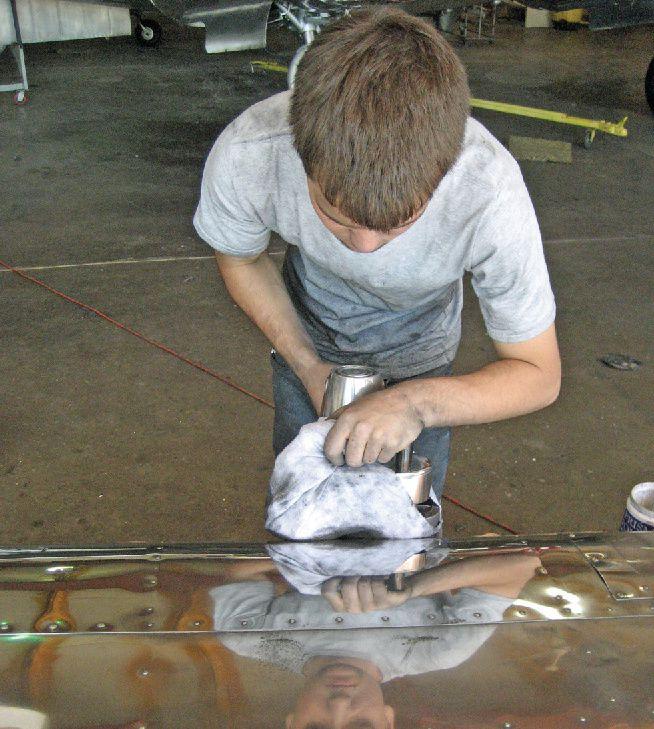
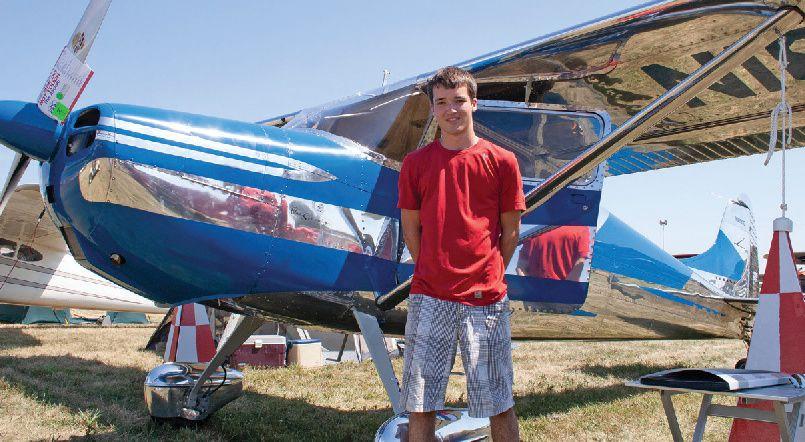
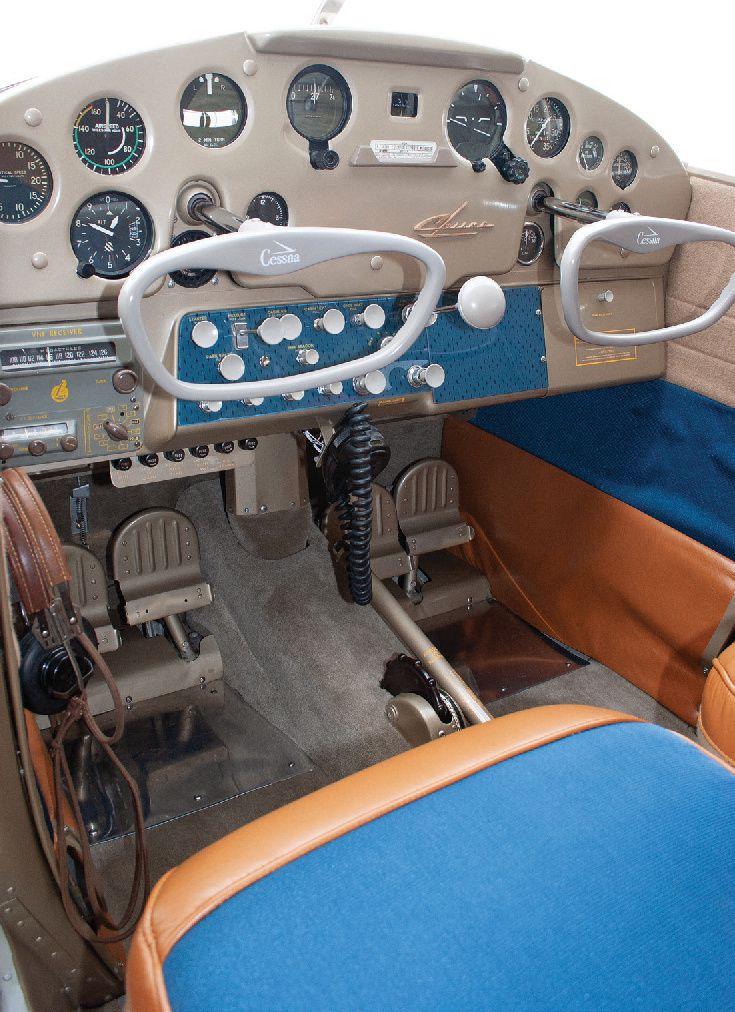
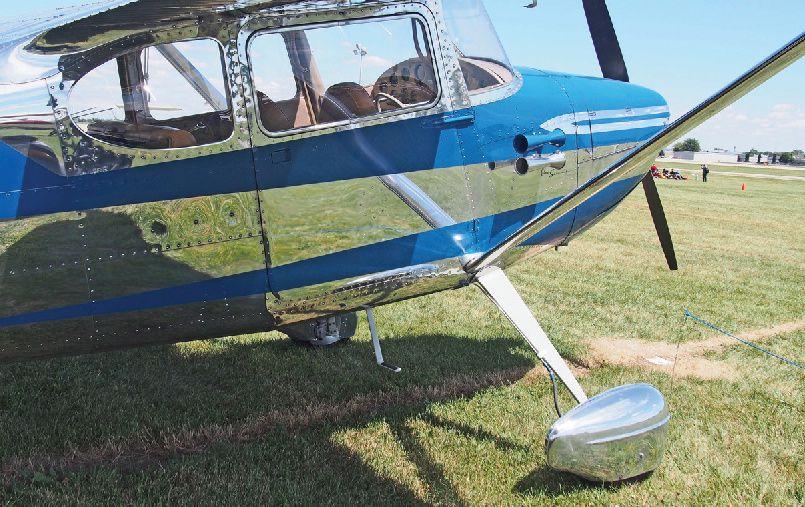
Aviation historian and author Joseph Juptner eloquently elucidated a few reasons for the 170’s popularity: “Altho’ deft and quite capable in the air, she was always gentle, quite tolerant, and had absolutely no bad habits; really a friendly kind of airplane, comfortable as an old shoe, that was very easy to like and very easy to respect. … The controls were light and responsive, and she could display a tom-boy streak now and then if cajoled into it, but she had certain instincts that never let her forget she was a lady. As a mechanical contrivance she was plain and nothing special, but as an airplane she was one of those that was easy to be with and hard to forget” (U.S. Civil Aircraft, Vol. 8).
The Model 170 was a larger, four-place version of the Cessna 140 two-seat trainer. The two models shared numerous parts in common, including spring steel landing gear, tires, wing ribs, cowlings, panels, and tail wheels. The 170 prototype flew in September 1947, and the “straight” 170 began rolling off the production line in the early spring of 1948. This rag-wing model had a wide door, which, in conjunction with front seats that easily rolled fore and aft on a track, facilitated entry and egress.
In a review titled “The New Cessna 170” in the July 1949 issue of Air Facts, Leighton Collins wrote: “There were 833 Cessna 170s sold in their first year of production — more than anything else during that same period, either two or four place.” There are currently 270 on the FAA Registry.
By May 1949, 1,000 had been built, and the 170A went into production. It retained the Continental C145 engine and featured design changes, including all-metal, tapered wings with larger ailerons, single lift struts (as opposed to the 170’s V-struts), and a dorsal fin. Around 2,250 170s and 170As were manufactured; there are 506 170As on the registry today.
By early 1952, the 170B began nudging out its siblings, and when production wound down four years later, nearly 3,000 170Bs had been built. Today, the 170B numbers 1,267 on the registry. The 170B’s refinements included larger wing flaps with 10, 20, 30, and 40 degrees of deflection, and the improved Continental O-300. All models of the 170 were eligible for floats and skis.
When the market began favoring tricycle landing gear, Cessna Aircraft followed that trend. It modified a 170B from its conventional gear to a tricycle undercarriage, thereby developing what would become the ubiquitous Model 172.
The 170 admirably filled a niche in general aviation during its production run from 1948 to 1956, and beyond. Well beyond, as a matter of fact, for
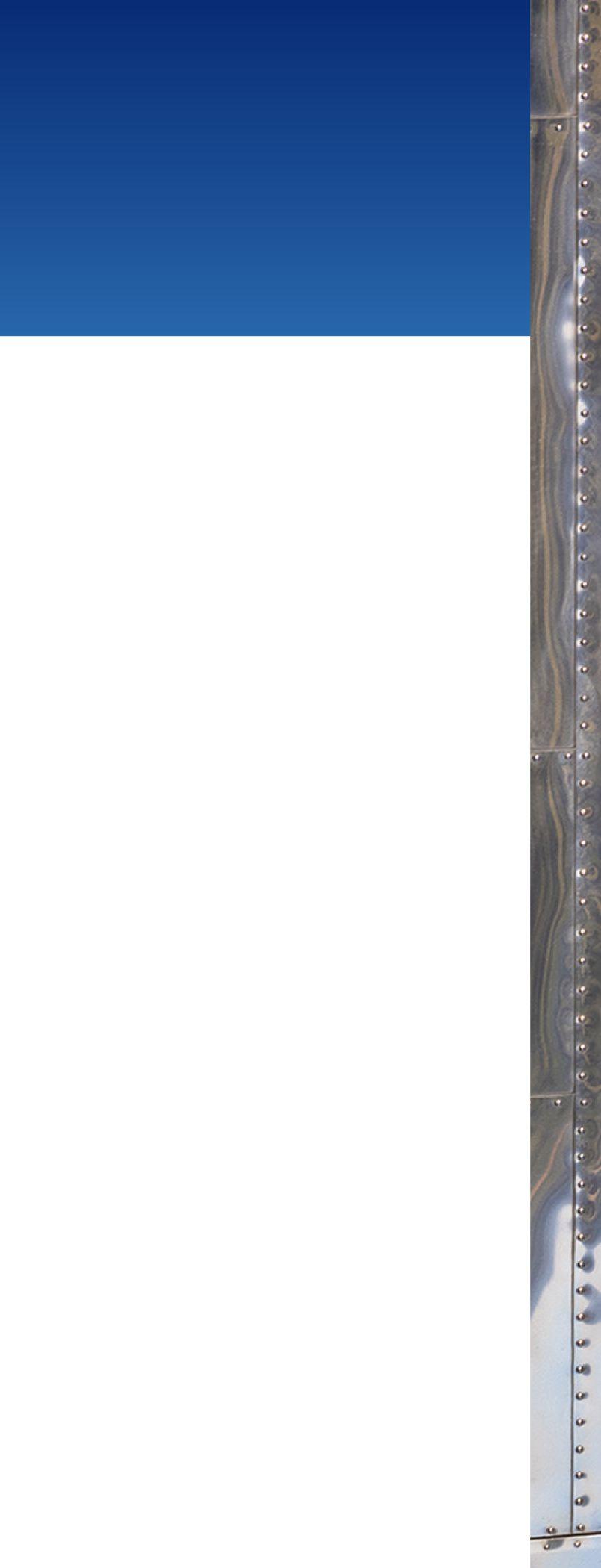
countless pilots to this day, and especially for one youngster in particular. Back in 2009, a 14-year-old named Dillon Barron took a shine (literally) to a forsaken and forgotten Cessna 170B. It could be said, in retrospect, that the young boy and the old airplane charted a new flight path for one another.
Dillon was born into aviation thanks to his father, Mike, and grandfather, John.
“My dad started me in a 170 when I was 4 — so I have a great background in aviation,” Dillon said. “I was learning at a young age how airplanes fly and how they’re built.”
By age 14, Dillon was well acquainted with flying airplanes, gliders, and sky diving. He didn’t yet know much about airplane restorations, but that was about to change.
N1899C was manufactured in 1953 as the up-and-coming 1954 model Cessna 170B and still had its original engine, instruments (except for the oil temp), and logbooks. It was up to Dillon, with paternal guidance, to delve into the daunting task of transforming a proverbial “ramp rat” into an airworthy airplane.
“This 170B was sitting derelict at the Hannibal airport when my dad started managing the airport,” Dillon recalled. “I had no idea what the caliber of this project would really bring later on. I was just in the moment and built the airplane like I wanted to. My dad and I got super deep into all the details of it.”
At the outset, Dillon just wanted to make the 170B flyable. But their quest for originality was sparked when they found some well-preserved materials in the interior, and the project turned into a highly focused, full-on restoration.
“I’m really happy I restored it back to original, because it has led to opportunities I may not have had otherwise. I’ve met lots of people because of it, and it’s given me a lot of self-satisfaction,” Dillon said. “I’m a big history buff, so every time I hop in the seat and fire it up, I’m happy that it’s living on as it should be!”
Parts of the weather-beaten 170B’s rudder were missing or damaged, so Dillon honed his metalworking skills and reskinned it, along with the elevators and horizontal stabilizer. But not all the work was hands-on. With an eye for details and an innate curiosity, Dillon invested a great deal of time researching almost every part of the airplane, large or
“I’m a big history buff, so every time I hop in the seat and fire it up, I’m happy that it’s living on as it should be!”
— Dillon Barron
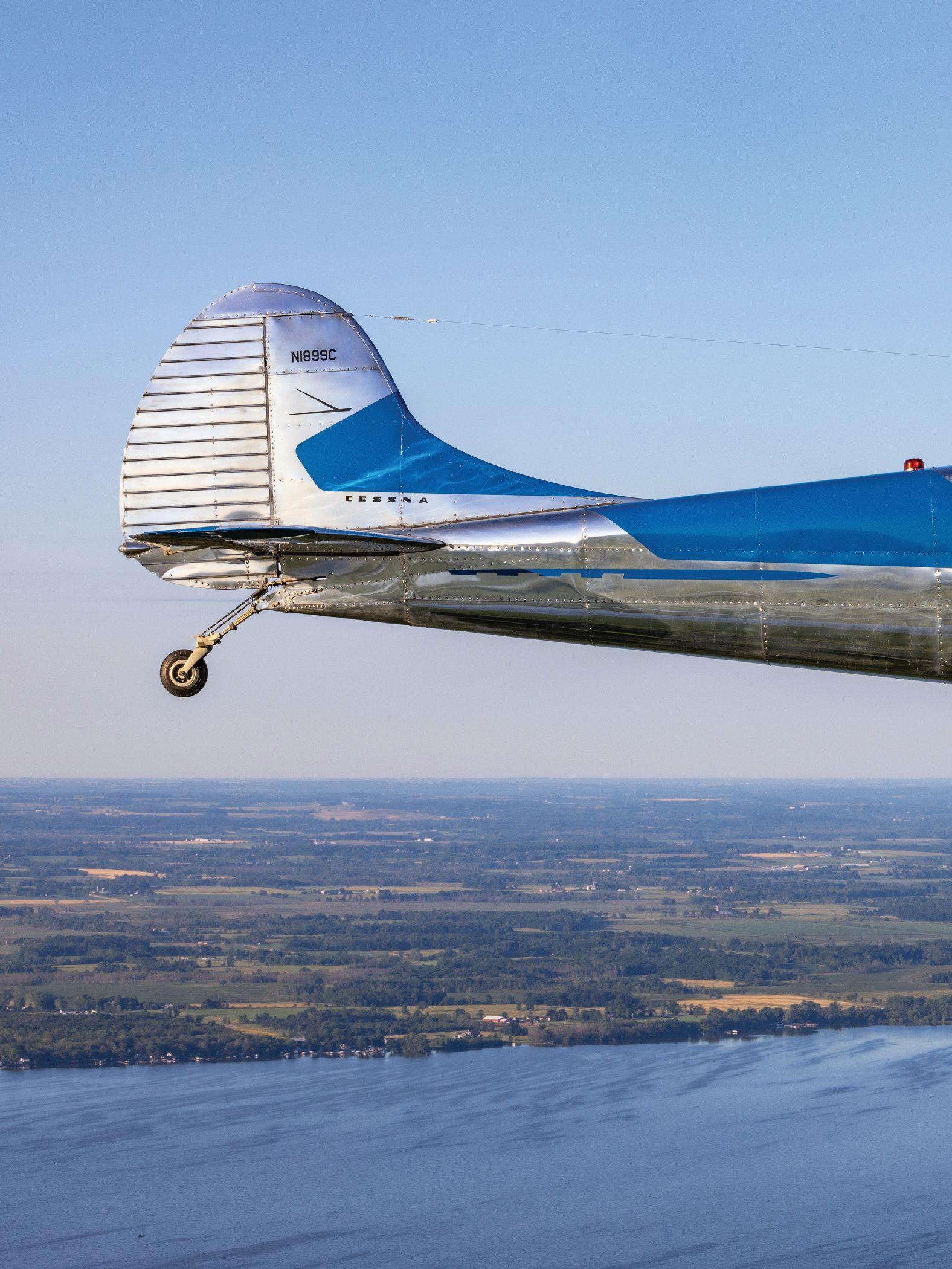

small, in order to restore it as authentically as possible. Resources for historical accuracy included information from the International Cessna 170 Association, an original Cessna owner’s manual, and period sales brochures and advertising. The 1954 model didn’t seem to be well documented; hence, he found himself investing numerous hours just to analyze old photos in order to confirm the correct year model. From red cap nuts for the screws that hold the metal strip in place on the center of the windshield to the patterned panel and more, Dillon became quite a sleuth at discovering details and then ciphering how to replicate them.
One of the first things Dillon tackled was removing, bead-blasting, and overhauling the tail wheel assembly, all the way down to the tiny Scott data plate. After painting, it was reassembled with new hardware and a new tire. That “subproject” instilled confidence for another task — redoing the main gear. Tackling one item at a time yielded pleasing and tangible results, which served to bolster Dillon’s determination throughout the restoration.
After poring over period photos, Dillon figured out how to replicate the original decorative diamond pattern for the lower panel on his computer. He cut a new piece of Plexiglas using the old one as a pattern, and smoothed his decal of the diamond pattern onto it, followed by press-applied yellow lettering. He finished it by painting the reverse side blue. The panel’s classic appearance was made complete by the original embossed Cessna logo on the upper panel.
Dillon applied a smaller version of that logo to the yokes. “That logo was kind of a chore,” he recalled. “I painted those by using a stick-on vinyl paint mask, and then spraying it with white auto paint. The trick was carefully removing the mask in
pretty much one piece — but then I had to pick out the little centers of the ‘e’ and ‘a.’”
Prior to stripping the fuselage, Dillon photographed and measured the stripes, so they could accurately lay out and paint the stripes later. Dillon used a compressed-air, gravity-feed paint gun to apply the Sikkens base coat and clear coat. With a steady, youthful hand, he carefully painted the “One Seventy” script on the nose.
During the initial teardown, Dillon discovered and saved small swatches of the original carpet and mohair headliner that hadn’t faded. He used those, along with a few interior samples from another vintage 170, to find matching new-old-stock blue nylon for the seats. New leather was procured from Douglass Interior Products, and a local seamstress replicated the interior.
With a bit of initial trepidation, Dillon proceeded, with guidance, to tear down the engine. Fortunately, there was little corrosion, which lifted his spirits by making the rebuild seem less complicated. They had the cylinders chromed and replaced the cam, pistons, rings, and bearings.
“I started figuring out how it all fits and works together,” Dillon said. “Now when I fly, I can picture the whole engine working — it’s really cool.”
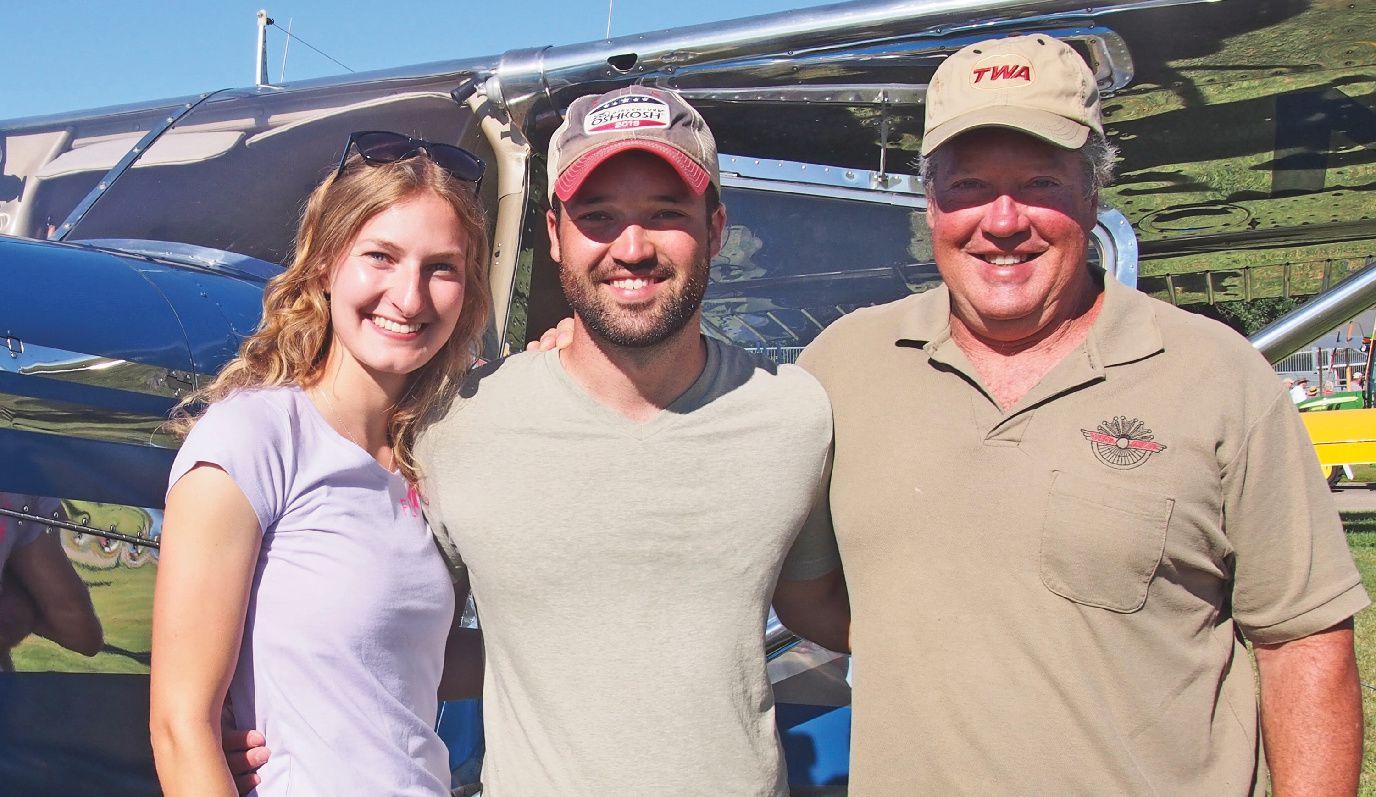
Remember, Dillon was a high school student throughout the restoration project. As devoted as he was to the 170B, he was still able to excel in his
JULY 24 - 30
EAA.org/Tickets
Bookmark EAA.org/AirVenture for AirVenture 2023 updates
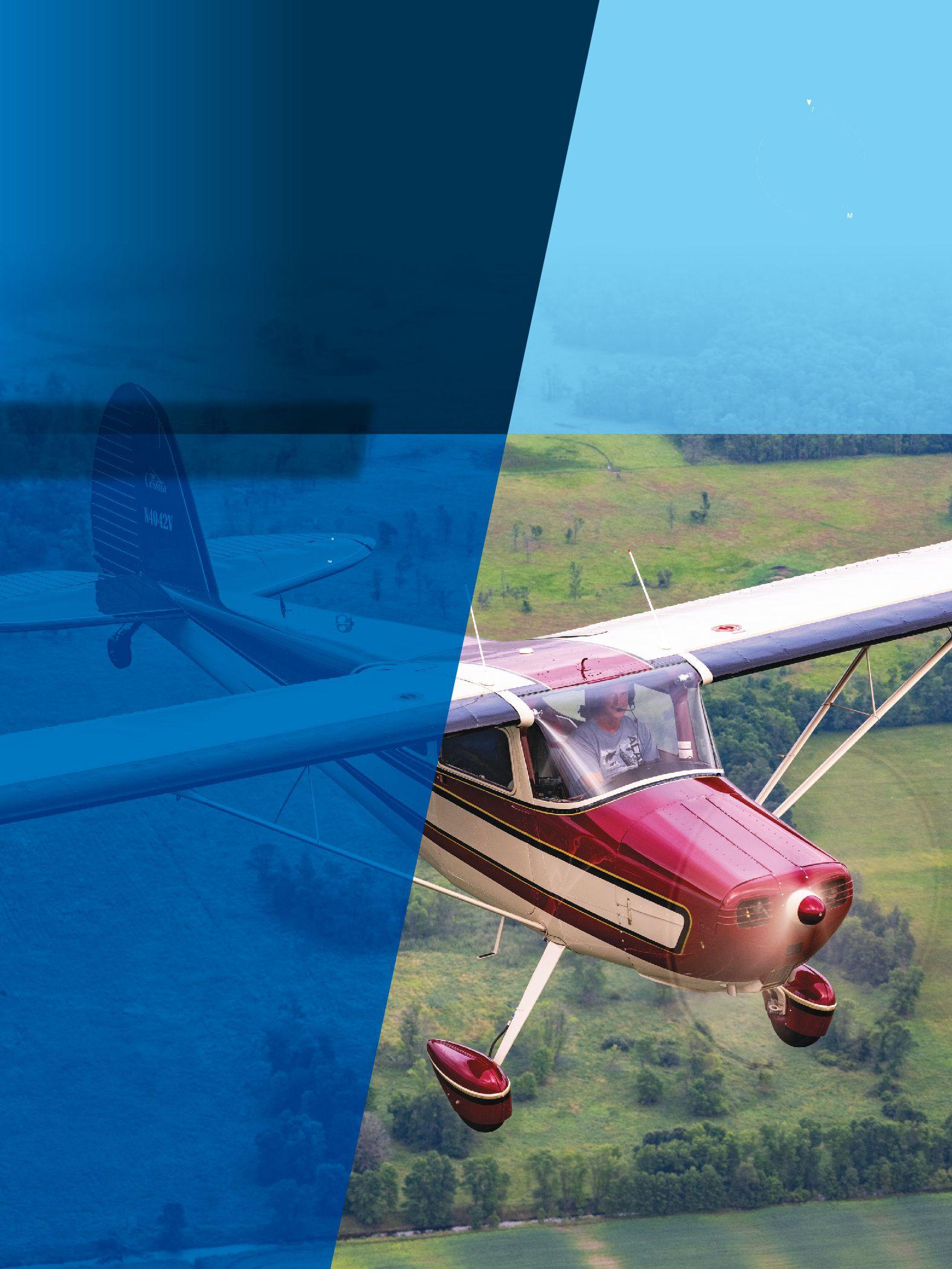
coursework. Oh, and then there were flying lessons and learning how to handle a tailwheel aircraft. When he soloed on his 16th birthday, it was especially memorable because he flew half a dozen conventional-gear airplanes: a 170, 195A, 195B, LC-126, Twin Beech, and an AT-6.
When it came time to make the first flight in N1899C, Dillon felt well prepared and was focused on emergency procedures — just in case. Afterward, the thrill of flying an airplane he’d restored with his own hands enveloped him with an emotion that was new to him; it was an intensely personal awakening, gilded with pure exhilaration.
When Dillon flew his freshly finished C-170B to EAA AirVenture Oshkosh in 2012, he was in for a few surprises. One of them was listening to 170-related memories shared by passersby.
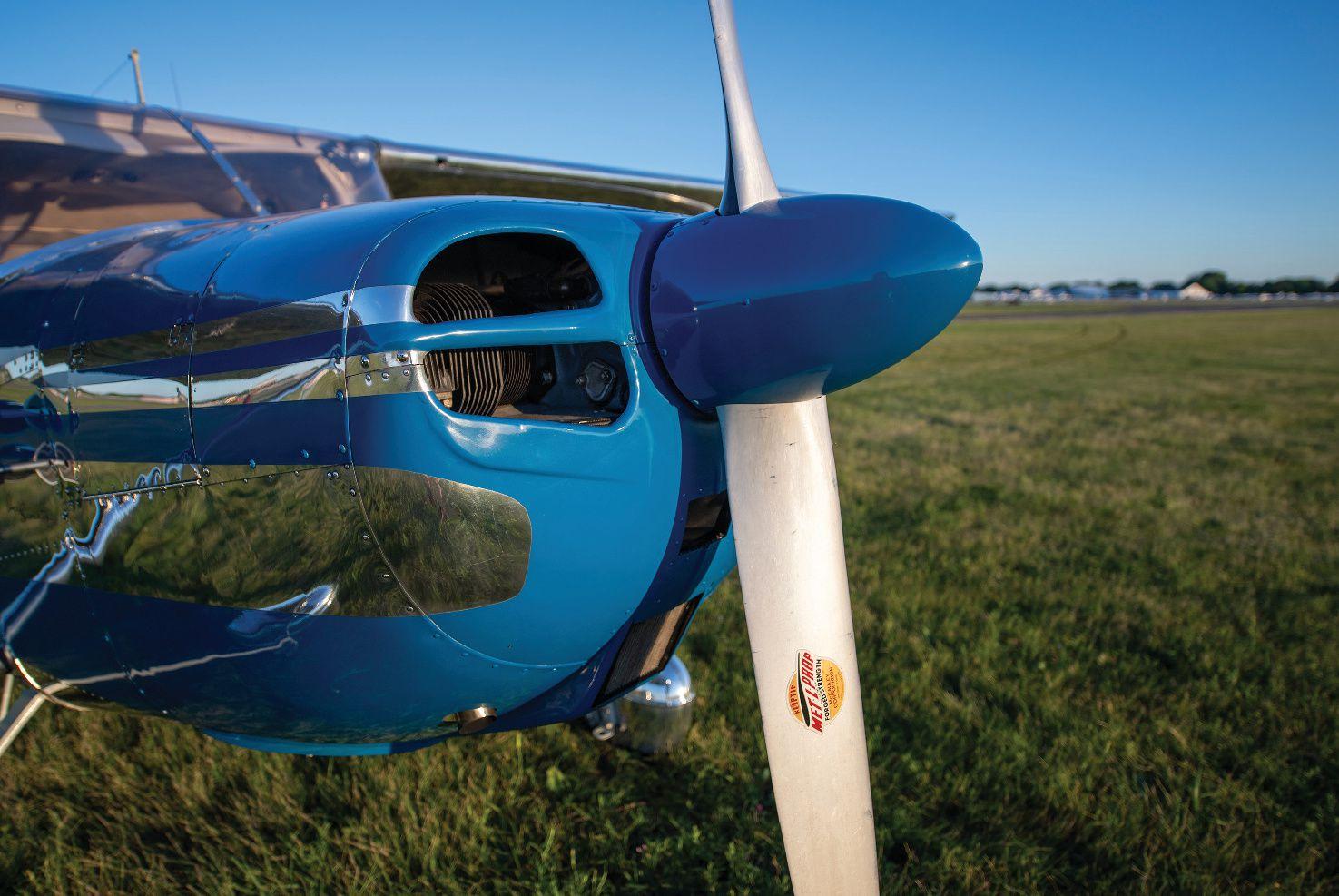
“Seeing guys’ eyes light up when they saw the airplane looking like what they so vividly remembered was great. I think that kind of brings out the youth in the older generation, and they’re passing the torch to us now,” Dillon said. “That’s probably the most rewarding part for me — the camaraderie of the people that just want to share their stories. I think that was the biggest reward, hearing people say that seeing it brought back so many childhood memories. That hits home with me; that’s really fun!”
There was another surprise that was presented during the awards ceremony. Dillon received the 2012 Reserve Grand Champion Silver Lindy (Classic, September 1945-1955) for his restoration of N1899C. He continued refining the 170B’s appearance, and two years later, he received the 2014 Grand Champion Gold Lindy.
“The thing I improved upon the most was the metal detail and polish. I worked harder at dressing some of the ‘use and abuse’ out of the original skins. I was able to do so by switching to Nuvite and their different compounds,” Dillon explained. “I tried several different polishing product brands first, but the finished product really speaks for itself when it comes to Nuvite.”
Ten years ago, a 17-year-old Dillon was interviewed by the author for an in-depth story on his restoration (Vintage Airplane, Vol. 41, No. 3). At that time, he made an observation that holds true to this day: “A good opportunity can really take you far; you just have to pursue it, and throw all your will and effort into it. Devotion will take you a long way. There’s no better reward than having a finished airplane you can call your own.”
Dillon has enjoyed flying N1899C ever since and has logged around 400 hours in it, in between his many other aviation endeavors.
“My 170B has been a solid airplane and has given me some memorable flights. For instance, my dad and I took it down to Florida for SUN ’n FUN and flew it along the coastline,” Dillon said. “More recently, my now-fiancée, Abby Wells, and I took it up to Mackinac Island, Michigan, and stopped along some grass strips on the way. We saw some beautiful scenery and crystal clear lakes — it’s an ideal airplane for traveling!”

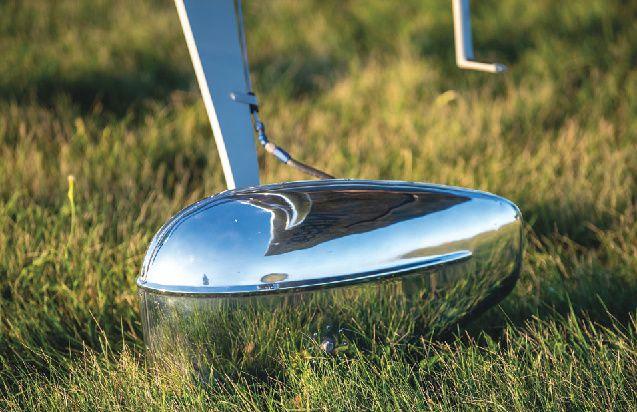

One thing often leads to another, and Dillon’s 170B restoration initiated a contact and an invitation to become a judge for the Vintage Aircraft Association during EAA’s annual AirVenture convention. That contact was Vintage Contemporary Judge Dan Wood of Newnan, Georgia, who had previously meticulously restored N4252V, his own 1948 Cessna 170 (EAA Sport Aviation, Vol. 58, No. 2). Dan had followed Dillon’s doughty efforts on the 170B restoration, gladly sharing his Cessna 170 knowledge with him whenever Dillon had questions.
“We were aware of Dillon’s restoration of his 170B long before he first brought it to Oshkosh,” Dan said. “After discussing the restoration with Dillon, we became more impressed with his level of detail, technical knowledge, and his enthusiasm. When the opportunity for a Contemporary judge came up, Co-Chairman Dan Knutson and I agreed he would be a great fit. VAA is very fortunate to have Dillon and several other young members contributing to the association.”
Dillon was invited to become a judge in 2015. “They needed some up-and-coming judges to fill some slots in the Contemporary category,” Dillon said, “and they needed a Cessna fill-in, which goes right along with what I’ve learned the most about. I couldn’t have been more honored when Dan Wood asked me to join them; that really meant a lot to me. I love being a judge, and I’m happy to be one of the younger ones to continue on in that role. Aviation needs youth involvement, and it’s uplifting to see more youth getting into restoring airplanes and bringing them up to the big show. EAA and Vintage are big players in that; they’re very welcoming and encouraging. That’s absolutely what needs to happen more and more throughout the aviation industry. Getting involved in aviation isn’t really hard to do; you don’t have to grow up in an aviation family.”
Dillon had a slight diversion in his aviation career when Mike’s dream to own a Grumman Albatross dominated their energies and resources. Barron Aviation’s efforts were highlighted in filmmaker Dirk Braun’s Flying Boat documentary. Mike dared to take on the Herculean task of rescuing seven derelict Albatross G-111s from Pinal County Airpark before they were scrapped and recycled. Once owned by Chalk’s airlines, they had been converted to standard category for civilian use just before being parked in the desert, where they sat for three decades. Mike was given 18 months to remove them and decided it would be best to fly them out. He and two helpers made it happen; they flew the Albatrosses out of the sand to Hannibal Regional Airport in Perry, Missouri, by the deadline of July 2018.
Afterward, the thrill of flying an airplane he’d restored with his own hands enveloped him with an emotion that was new to him; it was an intensely personal awakening, gilded with pure exhilaration.
That Albatross work was a lot, but we got them out. Now we’re getting back to fixing ours up,” Dillon said. “That’s where my heart is — the old-school radial engines and vintage aircraft restorations.”
In the 10 years since he completed his 170B’s restoration, Dillon has accomplished quite a few things: He has his single and multiengine sea and land; ATP; flight instructor for single-engine and glider; and type ratings in the Grumman Albatross A/G-111 and A/CL-65. He also holds the advanced United States Parachute Association’s Skydive D rating, having achieved the minimum required 500 skydives. He acquired his A&P certificate in June 2016 and finished his degree in aviation management aeronautics/aviation/aerospace science and technology at the University of Central Missouri in 2017.
Restoring N1899C allowed Dillon to develop a network of aviation contacts and propelled him to pursue his own flight path.
“I flew under Part 121 for about a year, and it was fun. I’m glad I did it, but it’s just not what I want to do,” Dillon said. “So I’m switching back full gear into the family business, Barron Aviation. I want to do top-tier quality work, because that’s where my passion is. I already have Cessna 170 and 195
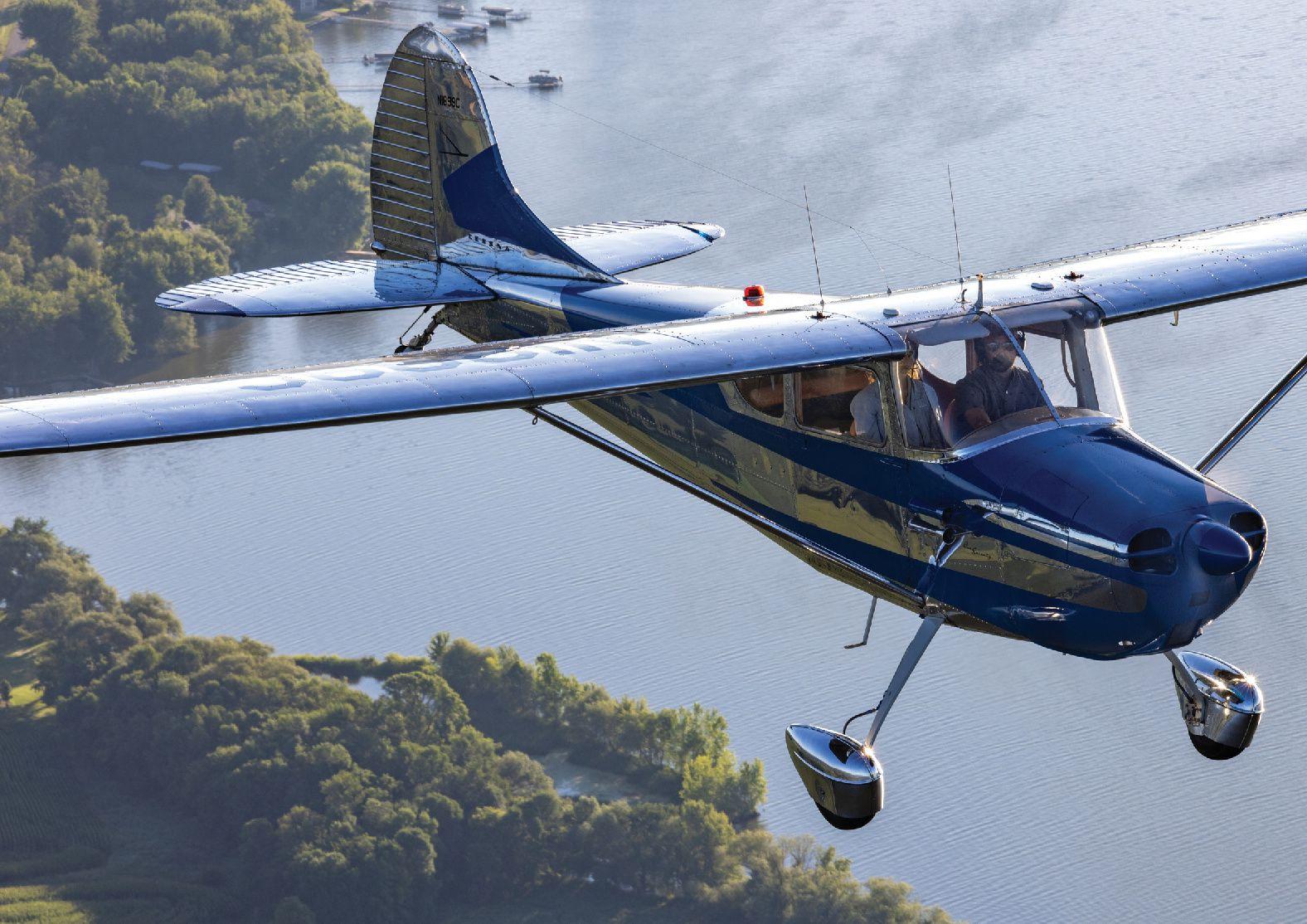
projects going now, and plans for the future that I’m trying to coordinate. We also broker aircraft; we have a good variety of services available.”
As the manager of Barron Aviation, Dillon is currently working on his A&P inspection authorization. He likes restoring aircraft just as much as flying them, and with the combined experience of three generations, Barron Aviation specializes in classic vintage aircraft repair and restoration. Its niche is structural repair and restoration of Cessna 190/195s.
“The neatest thing for me,” Mike said, “is that my son and I absolutely see eye to eye on issues of quality and how to run a business. It’s really exciting to have him taking the helm.”
Abby, Dillon’s fiancée, is a private pilot who logged some time in a Cessna 140 before starting to fly the 170B. She thoroughly enjoys N1899C, and they flew it to Oshkosh in 2022.
“This is my first time at AirVenture, and I love it,” she declared with an exuberant smile. “You
wake up with airplanes, and you go to sleep with airplanes!”
Dillon, quite naturally, remains a loyal proponent of the perennially popular Cessna 170 models and looks forward to many more decades of flying his 170B, as well as carrying on the family business.

“People say, ‘Enjoy life now, because it keeps going faster and faster.’ Well, this 170B is a true testament to that, because it doesn’t seem like 10 years ago that I finished the restoration,” Dillon said. “So it’s kind of sobering. Make sure you enjoy your life, decide what you really want to do, and don’t always chase the dollar. Don’t let anybody discourage you from taking on a project, and don’t talk yourself out of it; say ‘yes!’ If you want to do it, there’s always a way, and it’s usually not as hard as you might think it is!”
Not eligible to be flown by a sport pilot.
ENGINE: 145-HP CONTINENTAL C145-2
LENGTH: 25 FEET
HEIGHT: 6 FEET, 7 INCHES
WINGSPAN: 36 FEET
EMPTY WEIGHT: 1,205 POUNDS
USEFUL LOAD: 995 POUNDS
PAYLOAD (WITH 42 GALLONS OF FUEL): 558 POUNDS
BAGGAGE: UP TO 100 POUNDS
GROSS WEIGHT: 2,200 POUNDS
MAX SPEED: 140 MPH
CRUISING SPEED: 120 MPH
LANDING SPEED (WITH FLAPS): 52 MPH
STALLING SPEED (NO FLAPS): 58 MPH
CLIMB RATE: 690 FPM
SERVICE CEILING: 15,500 FEET
FUEL CAPACITY: 42 GALLONS TOTAL (TWO 21-GALLON WING TANKS)
OIL CAPACITY: 8 QUARTS

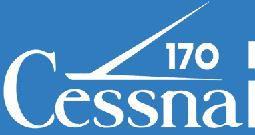
MIKE LEWIS, OF CARMEL, Indiana, was emphatic when he said, “I bought this airplane, a 1948 Cessna 170, for one reason and one reason only: Almost everything about the interior, especially the panel, was original. Nothing was modified or butchered. It was a hurting puppy in a lot of areas, and the panel was old, but the instruments were original. Better yet, there were no screwed-on patches or square glass faces staring out at me from holes where there weren’t supposed to be holes. Rag-wing 170s, which were only built for one year, are rare enough. However, finding one that didn’t have a cockpit that had been cut and tweaked beyond recognition is the rarest of the rare.”
This C-170 was a long time coming into Mike’s life. As far as that goes, Mike’s private pilot certificate was a long time coming, but it wasn’t because the interest wasn’t there. It was because nature played a cruel trick on him.

“I had always loved airplanes,” he said. “When I was 10, my best friend’s father, who was an aeronautical engineer, took me for a ride in their Aeronca Chief. And that was it! From that point on, I knew exactly what I wanted to do and how I was going to do it. I was going to college for aeronautical engineering, then work towards the airlines. Then, at 14, an eye doctor diagnosed me with an aggressive myopic condition. My eyes were going to keep me out of flying. I couldn’t meet the FAA’s eye requirements, and that was that. I was devastated! I cried all the way home. And, some part of me decided the only way I could cope with the disappointment was to do my best to ignore aviation. If I couldn’t do it, I didn’t want anything to do with it.
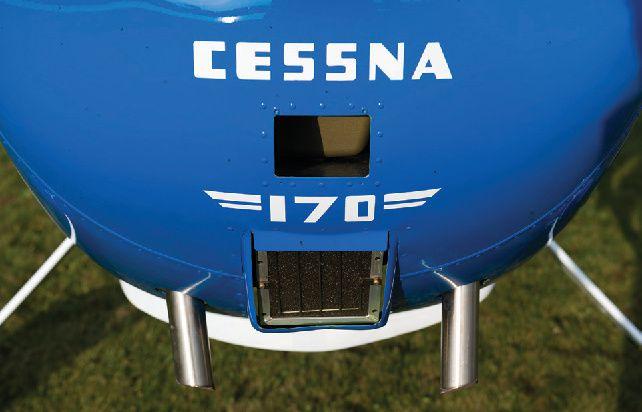
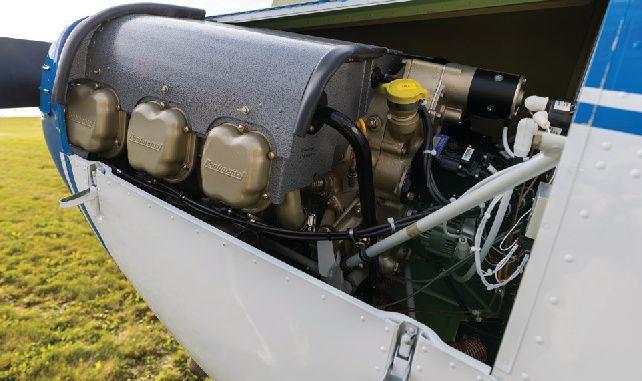

“When I went to college, rather than majoring in aeronautical engineering, I studied business, which, in the long run, turned out to be a good move,” Mike said. “Then, I was going through the normal things a young man encounters at that stage of life — family, kids, the usual — all of which would have kept me out of the air anyway. However, I still wanted to fly. The frustration was still there, but as an adult I was handling it better. More or less.”
One of the really good aspects of the passage of time is that every form of technology is building upon itself and continually getting better and better. This also applied to the medical aspect of eye care.
“By the time I was in my 40s, the FAA had become a little more tolerant of eye issues, and eye surgery had progressed by leaps and bounds,” Mike said. “Suddenly, I found that the barrier, my eye problems, was no longer a barrier, and I could learn to fly. So, at 44 years of age, I did.
“As for going the vintage route, I’m not sure that there was a time that I was suddenly drawn towards older airplanes,” he said. “I think it was basically always there, probably because of me getting my first flight in that Chief, which is about as vintage as airplanes get without being true antiques. My first airplane was a 152 with the Sparrowhawk engine conversion, but I only kept that for a short time. Then I bought a 170B with a 180-hp conversion.”
Mike said he didn’t initially buy the 170B with the intent of totally restoring it. But having a close friend who was an A&P/IA mechanic and an absolute metal wizard changed his mind.
“With him looking over my shoulder and me looking much more over his, he taught me a lot as we took the 170B all the way down and brought it back up. We took it to Oshkosh in 2008, where it won runner-up for Best Custom Classic.
“Then, I started looking down the road at my eventual retirement and began to wonder what I was going to do,” Mike said. “I liked my 170B, but I was attracted to the ’48 170 because of the fabric wing. They are a little bit antique and a little bit modern. And today, having been built for only one year, they are not just another Cessna.”
The straight 170 (no A or B) had barely begun production before Cessna’s engineering staff and marketing department got together and started the string of ongoing changes that would eventually culminate in the legendary 172. While there
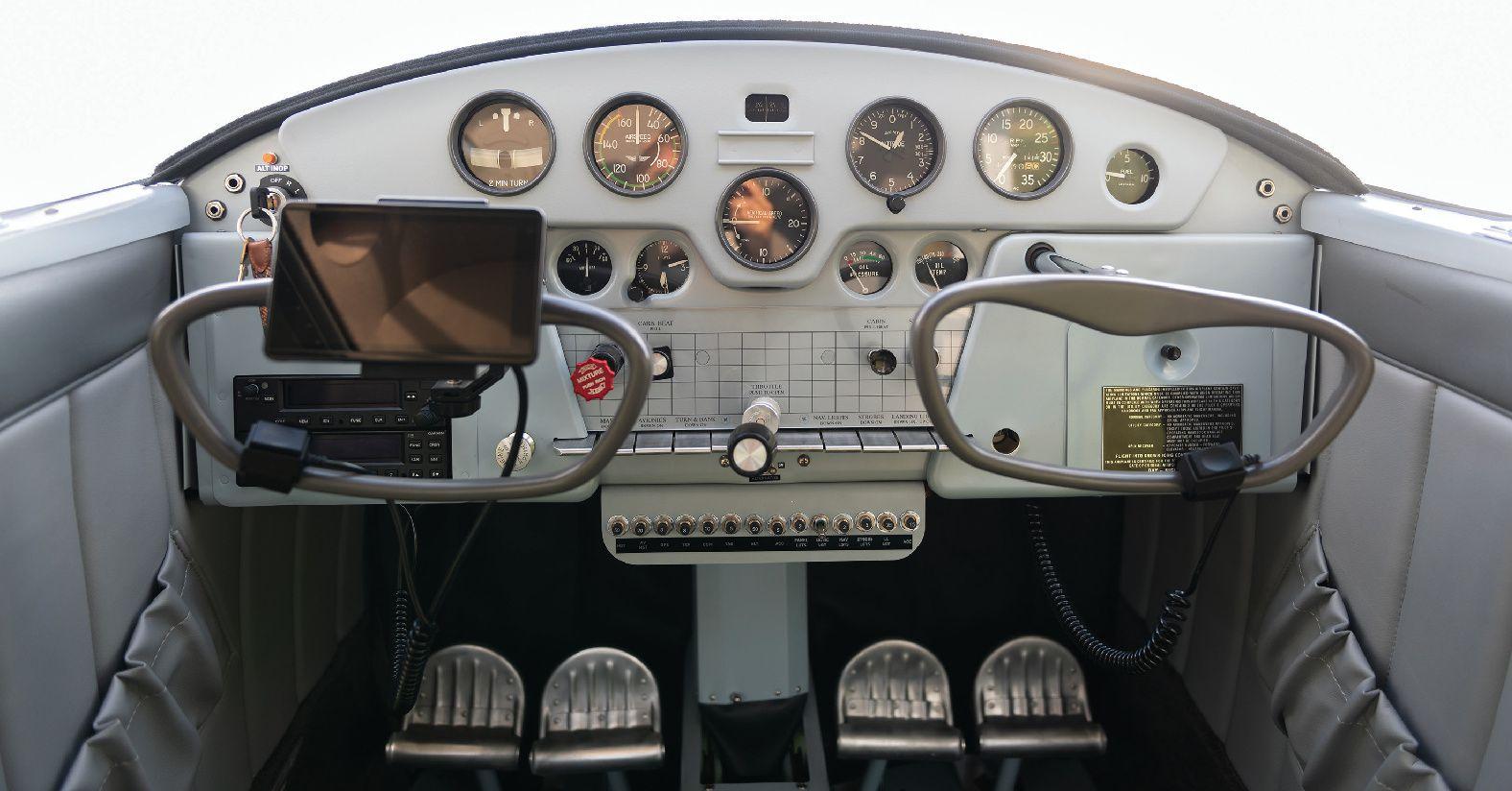
are those who think an original C-170 is an ugly duckling compared to the later C-170A, B, and then 172, it has to be recognized that, as dated as it may appear, it is the seed from which an aviation legend sprouted. And Mike Lewis saw it as the piece of history that 4112V, Vic, is.
“At some point, someone said to me that we don’t really own these airplanes,” he said. “We are just their temporary caretakers, preserving them for the next generation. And that pretty much characterizes how I feel about it and all the effort and money I put into Vic. If I hadn’t come along,
“As I walked up, I saw Vic as a complete, flyable, but very sad-looking 170. He wasn’t terribly beat up, but he definitely looked elderly. However, the second I looked inside, I was sold.” — Mike Lewis
it’s possible it would have been allowed to deteriorate even further and wound up being parted out.”
So, Mike started looking for a 170 two years before he was scheduled to retire.
“I spotted 4112V in Barnstormers, and when I saw pictures of the interior, I knew I had to go look at it,” he said. “So, I rode a smoker to Kansas City. As I walked up, I saw Vic as a complete, flyable, but very sad-looking 170. He wasn’t terribly beat up, but he definitely looked elderly. However, the second I looked inside, I was sold. I don’t think I ever thought I’d find that good of an instrument panel, and on a 64-year-old airplane. So, I did an intensive preflight, fueled it up, and headed for home. The flight was absolutely flawless.”
Mike said the logs indicated the airplane had never been totally restored; it was just kept flying.
“However, it was 64 years old and made out of aluminum,” he said. “It not only had its share of nicks and dings, but I was certain corrosion was going to be a problem, so I went looking for it everywhere, starting with the cowling. The nose bowl was in pretty good condition, but I drilled all the rivets out of the cowling, regardless, cleaning and repairing as I went. The holes in the bottom of the cowling where the exhaust exited were badly beat up and egged out, so I flush-riveted doublers, rounded the holes back to original, and cleaned up the air box area. My A&P/IA friend turned me on to some Bondo that actually flexes, so the nicks and creases I couldn’t iron out were smoothed with that.

“The firewall hadn’t been terribly cut up, but it had excess holes, and I drilled it out of the fuselage so I could clean it, the surrounding inside areas, and have unfettered access to rewire the panel. I filled the holes with No. 5 soft rivets, which painted over nicely.”
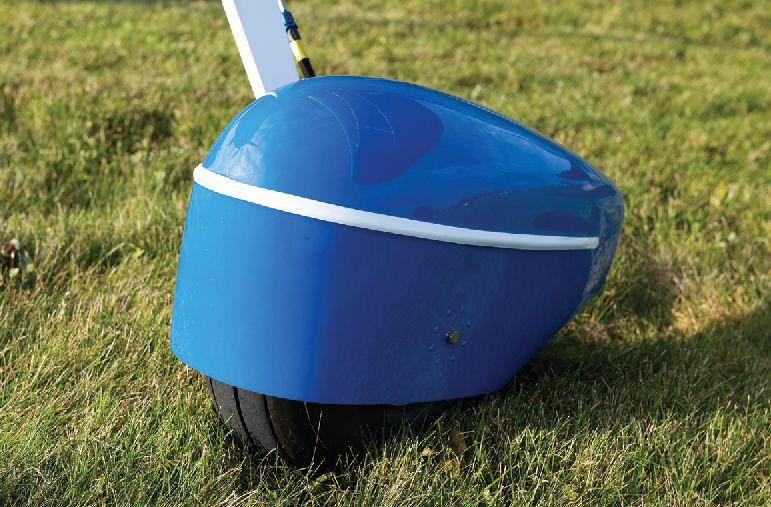
Mike knew from the start he was going to overhaul the engine, so he took it off, pickled it, and put it in a closet at home.
“This says a lot about my wife,” he said. “It stayed there for nine years. It was the original engine, a C-145-2A that had 1,600 hours on it when I bought the airplane. It was a fairly rare
engine that I basically ignored while I finished up the airframe. I’d flown that engine for over 100 hours, so I knew it was good, but I also expected the crank to be a problem because of age and low time. And it was.

“At overhaul, the crank failed inspection, but Jim at G&N Aircraft, who overhauled it, had an overhauled crank on the shelf that had been there for quite some time,” Mike said. “Jim sold it to me for half off. Considering that he knew I was backed into a corner and needed that crank, that was pretty amazing! You meet some of the finest people in aviation.
“During the overhaul, we improved technology by adding a Plane-Power 50-amp alternator, a B&C lightweight starter, and switched back to Bendix magnetos,” he said. “Another person like Jim was Tim in parts at Ying-Ling

Know who these guys are? Who they became? They were best pals way back then, always together just like Abbott and Costello or even Hope and Crosby Today their names are so powerful that family lawyers have forbidden us from revealing them. Maybe you can tell who they are from their innocent
Did they have something important to do with aviation? Not exactly It was more about what aviation had to do with them
Why are they notable? How did they change our lives? Well, the guy on the left (we’ll call him Phil) invented those little bamboo umbrellas they put in fancy drinks Genius! The guy on the right, (let’s call him Dave) a true visionary, came up with the little tabs on zippers It goes to show that an early interest in aviation can send a young man down some wonderfully productive and lucrative roads
So buy your kid an airplane!
“So, now, essentially, I have a brand-new, 75-year-old flying machine that will get me where I’m going just as well as a 2023 model could.” — Mike Lewis
Aviation. When I couldn’t find something, I could call Tim and he would source hard-to-find parts across the country. He never failed — simply a great guy.”
When it came to restoring the fuselage, Mike said he was incredibly lucky.

“It was pretty dirty inside but was quite straight and had very little corrosion,” he said. “I replaced no skins, but I did drill the floorboards out to carefully examine the gearboxes. On old tailwheel Cessnas, the gearboxes are often severely tweaked and need replacing. These were fine, but I put the P.Ponk stiffeners on them to keep them that way. I got in there with a dental pick and brushes, and then cleaned the entire area until it did everything but shine. I used a stripper inside and out on the fuselage, Scotch-Brited inside and out, and finally epoxy primed. The top of the cabin came
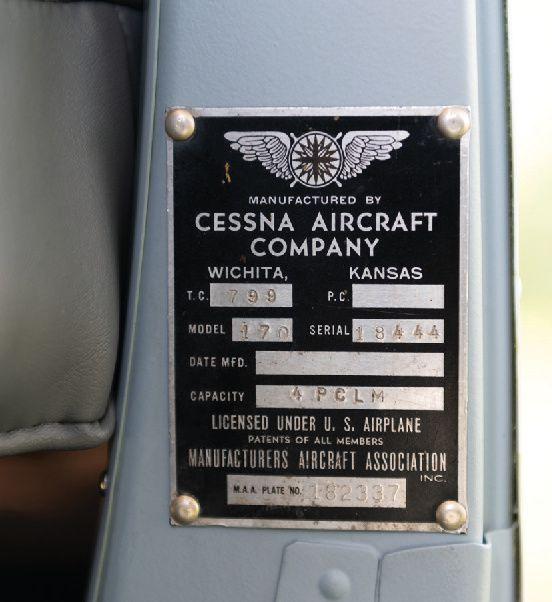


off, and the spars were Scotch-Brited, epoxy primed, and coated with a corrosion inhibitor with the consistency of molasses.
“Prepping the parts to be primed turned out to be the most laborious and dirty part of the restoration,” he said. “I was looking at this airplane as something to keep me busy after retirement, but that aspect of it seemed to take forever. Right now, I feel as if that effort alone, when coupled with my age, may keep me from doing another restoration of this magnitude. I did say ‘may.’
“The tail is difficult to inspect because so much of it is riveted closed and you can’t see inside,” he added. “So, I drilled the vertical stab completely apart, and it wasn’t bad inside. The rest of the tail was just cleaned and primed based on a borescope inspection.”
Mike said his luck ran out with the wings.
“As good as the fuselage was, that’s how bad the wings were,” he said. “They had been metalized and trapped moisture. There was corrosion everywhere. It was so bad, I couldn’t even offer them for sale as I planned on returning the plane to fabric wings from the beginning. The ailerons were repairable, so I drilled them apart like the cowling, but the flaps were as bad as the wings, beat up and corroded. So, I purchased new corrugated skins, took them completely apart, every rivet and spot weld, and essentially built new ones. I should mention that all of this was being done with an A&P watching over me.
“I found a set of fabric wings in Minnesota that were hanging up in a barn. My A&P/IA friend and I flew the 170B up to a grass strip where they were housed, inspected them, purchased them, and brought them home.
“I didn’t have any experience with fabric, so, when I started work on the wings, I had an A&P/IA in tow who was good with fabric,” Mike said. “I had built a PVC pipe and plastic-covered paint booth in my shop and had a rotisserie for the wings. We covered the right-hand wing, and then a sad form of divine intervention happened. My A&P/ IA’s family had health problems, and he disappeared for over a year. I finally sent the wings off to King Aero Aviation Services in Elkhart, where Marty King worked magic with both wings. He got the Poly Fiber Randolph Aero-Thane to glisten.”
Mike also got some help when it came to painting Vic
“I enlarged the paint booth to accept the fuselage, tail feathers, and flight controls,” he said. “I used 14 box fans, furnace filters, and a squirrel fan to move air and trap overspray. I stumbled upon a local aviation painter with 30 years of experience who wanted some after-hours work. He

reviewed the project and the booth and agreed to spray, with me doing the prep.
“The colors were Juneau White, which was a color of the ’40s era, and Colonial Blue,” Mike said. “To lay out the scheme, Dan Wood, who owned a ’48 170 he restored with an accurate paint scheme, came to the rescue. He shot a bunch of photos of his trim while holding a ruler up in the photo. The detail was so good that I could position the trim by counting rivets and knew it was accurate.
“I really wanted to use a set of original aluminum wheelpants, but finding a good set turned out to be impossible, and the factory wanted right at seven grand for a set,” he said. “I couldn’t justify the cost against the abuse the soft aluminum would take over the ensuing years. Hence, I ordered fiberglass blanks from Wag-Aero and fabricated the pants for roughly 7 percent of the factory’s price.”
Mike’s decision to buy the airplane based on the condition of the instrument panel and the interior turned out to be a good one. It took far fewer hours to produce a totally authentic-looking interior than almost any other part of the airplane.
“When I bought the plane, the owner had just installed a new Airtex upholstery kit, which was pretty authentic to the period,” he said. “I put in a new headliner and carpet but didn’t like how the floor tunnel looked. So, I had a local upholstery shop make a tunnel cover in leatherette that really finished off the floor. So, I’m pleased with the overall result regarding the upholstery.
“Doing the instrument panel actually turned out to be enjoyable,” he said. “It made up for some of the drudgery of the airframe work. This was largely because everything about the panel was still original and in amazingly good shape. The instruments were all the originals that had come out of the factory with the airplane. So, just overhauling them gave me an original instrument group. The bank of piano-key switches the 1940s Cessnas are known for, that run across the panel, actually activate normal toggle switches inside the panel. So, polishing the keys and replacing all the switches was easy. None of the fascia pieces that form the face of the panel were cut or
dinged. It was a simple matter of stripping and painting them.
“Once you’ve done the instruments, switches, circuit breaker, and fascia pieces, you’re pretty much done,” he said. “I did fabricate a new plastic overlay for the controls and switches and had a print shop do the artwork. For a radio and transponder, I installed a Garmin 225 comm and a 335 txp in the factory’s original panel access, but I put no navigational glass anywhere. Instead, I just depend on a Garmin Aera 660 clamped to the yoke. Can you imagine what a 1948 pilot would think if he or she could see what kind of nav aids we now can carry in our pockets? It would be pure science fiction to them! And it makes cross-country flying so easy for us.”
Mike said one factor that made the whole process drag out toward the end was the pandemic and supply chain issues.
“Getting even mundane stuff sometimes took much longer than expected,” he said. “However, you just keep pushing, and sooner or later, you’re finished. So, now, essentially, I have a brand-new, 75-year-old flying machine that will get me where I’m going just as well as a 2023 model could. Would I do it again? Well ….”
Inasmuch as Mike Lewis, the teenager, was depressed because he thought he’d never be able to become a pilot, it can easily be said that he has overcome that temporary handicap. Judging from the effort and detail he has put into N4112V, it could also be said that he has overcompensated. In the process, he has clearly preserved an aerial artifact for future generations.
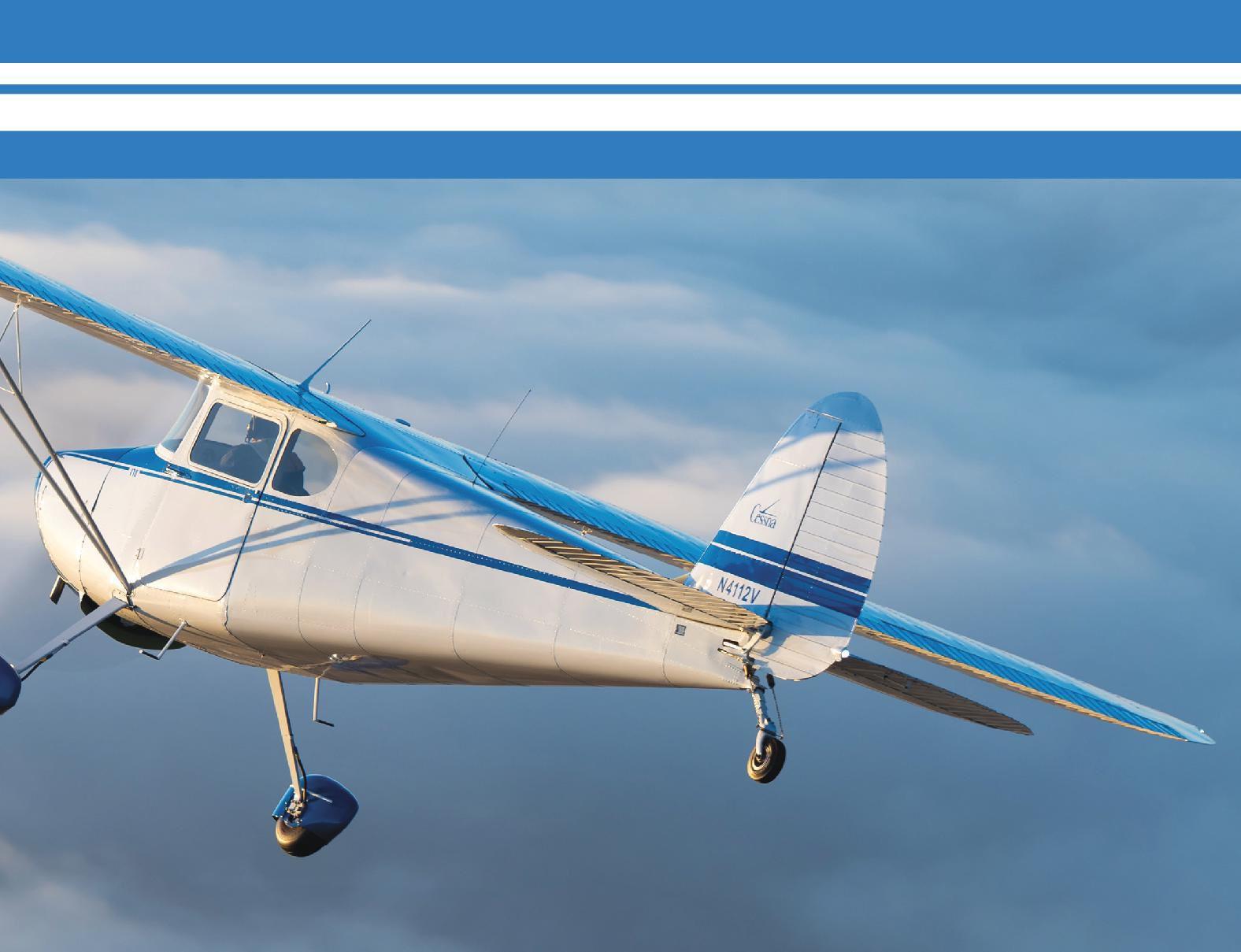



THE CESSNA AIRCRAFT COMPANY, after producing over 5,000 T-50 Bobcat multiengine trainers for the military during World War II, re-entered the civilian airplane market with the two-seat 140 series airplanes in 1946. This small airplane has a gross weight of only 1450 pounds and a useful load of 590 pounds. In 1947 the much larger 195 type airplane with five seats was added to the product line. The 195 airplane design is, with the fully cantilevered wing and radial engine, very similar to the Cessna Airmaster that was produced from 1933 to 1941. The following year, 1948, Cessna began producing the four-place 170 to fill the large size gap and load capacity between the 140 and 195 airplanes. In its first year the 170 production equaled the 140 and greatly exceeded the number of 195s produced. For the next four years, the 170 was Cessna’s largest-production civilian airplane until 1953, when the Cessna 180 was introduced.
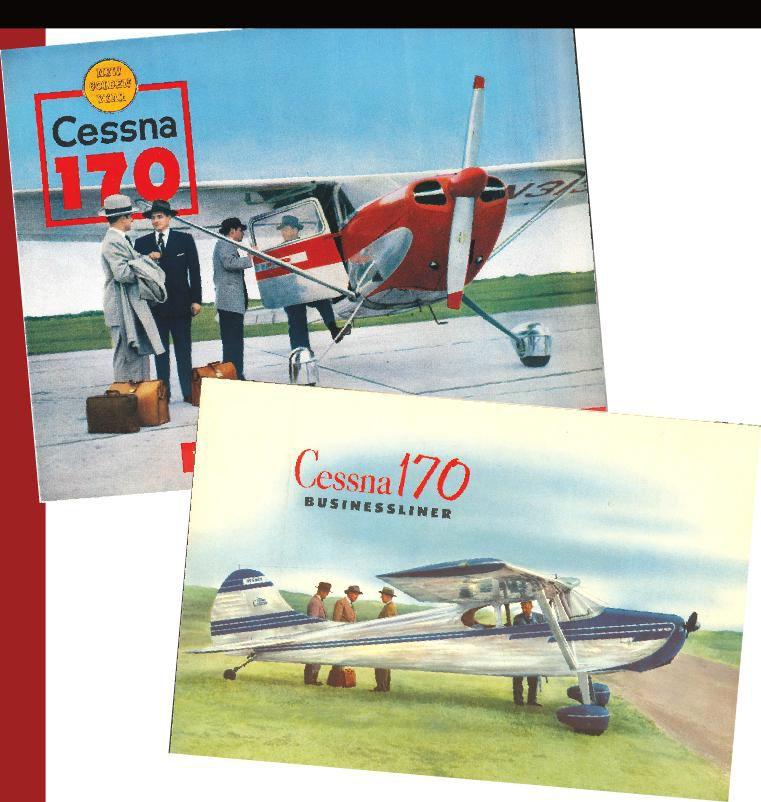
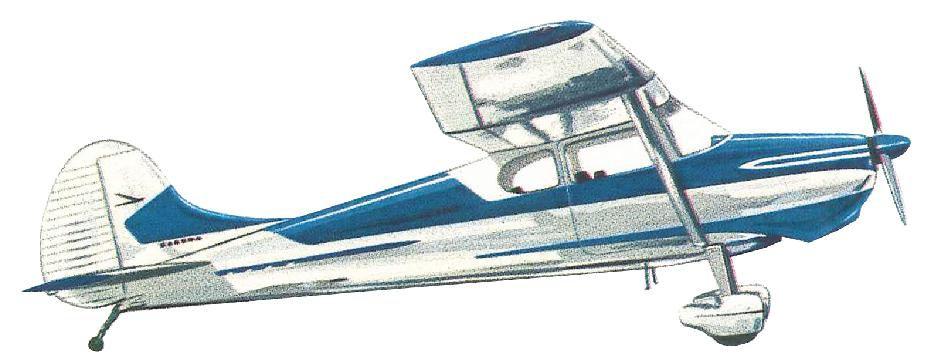
The 170 with the V-strut-supported, fabric-covered wing with an all-metal fuselage was a scaled-up 140 in nearly every way. The inner wing structure was all metal as were the control surfaces. The hinged flap extended to 30 degrees, with the total wing span increased to 36 feet. An enlarged and extended cabin made room for a rear seat and baggage compartment. The Continental six-cylinder C-145 is a stretched version of the four-cylinder C-90 engine with two O-200 cylinders added. A third 12.5-gallon fuel tank was added to accommodate the increased fuel burn of the larger engine. The 170, not having the dorsal fin of all the later models, can be easily mistaken for a 140 from a distance. Comparing the 140 directly with the 170 has the gross weight going from 1,450 to 2,200 pounds, increasing the useful load from 590 to 980 pounds. The optimum speed in cruise increased from 105 to 122 mph, going from the 140 to the 170. Although claims have been made
that the original 170 is 5 mph faster than the later all-metal 170s, the published optimum speed, wing loading, and airspeed limitation numbers are the same for all models of the 170. The only difference is the maximum flap extension speed. For the fabric wing 170, it is 90 mph compared to 100 mph for the later-model 170A’s and 170B’s.
The 1948 Cessna 170 was an immediate success. In its single year of production, the 170 led all other Cessna models, with 714 airplanes registered. Year 1948 production numbers for the other Cessna aircraft were 603 for the 140, 153 for the 195, 116 for the 120, and only 45 for the 190.


The year 1949 brought major changes in Cessna’s lineup of light aircraft. The complete abandonment of fabric wing covering and the V-strut support are the most obvious changes. The Cessna 170A was introduced with an all-metal wing and a single strut that attached only to the main front wing spar. The wing still had the hinged metal flap, but these were slightly larger and the flap travel was increased to 50 degrees. The wing has no dihedral, so the 170A is often referred to as the straight-wing 170. The other most obvious difference is the addition of the dorsal fin, the same as the 195, to the tail. Internal to the wings were two 21-gallon fuel tanks with a center vent over the cabin. Both of these tanks fed to a fuel selector located between the front seats. This increased the total fuel to 42 gallons, with 37.5 useable. The instrument panel with piano key switches is much the same as the panel in the 1948 170. In 1949, the first year of the 170A, it still had the large fixed-cowl flap on the outlet at the bottom of the cowl. In the following year, 1950, this was changed to the much smaller flap that was used on all subsequent 170 airplanes. Other than this, the Cessna 170A didn’t have any significant changes during its threeyear production run of 1,522 airplanes produced.
In 1950, at the start of the Korean War, Cessna started production of the L-19 ‘Bird Dog’ as a military support airplane. Production of the L-19 peaked in 1951 at 1,186 airplanes delivered. Cessna management decided to incorporate the wing and elevator of the L-19 into the 1952 170 and designated this airplane as the Cessna 170B. The wing on all the B models has a noticeable 3-degree dihedral. The wing also has a “washout,” or “twist,” outboard of the wing-strut (station 100), with reduced angle of incidence of the outboard section. This results in a slight preservation of aileron effectiveness, providing additional control during stall recovery. The flaps are a large semi-Fowler design with a maximum deployment of 40 degrees. Cessna called these flaps Para-Lift but they are commonly referred to as barn door flaps. The elevator shape was changed with weights added to the tips forward of the attaching hinge for counterbalance. This “balanced” elevator lightens elevator “stick” forces and externally is easily noticed, as the

trailing edge, when lifted and released, will gently “fall” down to the stops. This in contrast to earlier elevators which will fall with a noticeable “bang,” a possible contributing factor to damage of the internal fuselage bulkhead experienced in those earlier models. Also, the elevator trim tab is recessed into the rear of the elevator. These wing and control surface changes increase the inherent flight stability of the 170B airplane.




The 1952 170B is a hybrid airplane, combining major features of the A model with the wing and elevator modifications that originated in the L-19 airplane. The 1952 B still has the center hinge cowling with full opening doors on both sides and the internal pressure air box for cylinder cooling. Also, the cowl-nose has the same grill cover over the air intake like all of the earlier 170s. The instrument panel is where the first year B model is nearly identical to the earlier 170 and 170A. The layout of the shock-mounted panel, panel covers, piano key switches, control cable positions, and glove box and radio bay is all the same.
Production of the Cessna 170 peaked at 1,186 aircraft, making up 86 percent of Cessna’s civilian production in 1952.
The following year, 1953, the 50th anniversary of flight, Cessna continued with modifications that made the later 170B airplanes distinctive from all the earlier 170s. The cowling was changed to eliminate the center hinge doors, creating a full-pressure cowl. Small doors in the upper cowl provided access to the oil filler, dipstick, and battery. The instrument panel was completely redesigned, with push-pull switches replacing the piano key type. Panel space for radios doubled with two radio bays. The shock-mounted instrument panel was greatly expanded, making space for many more instruments and gauges. To aid in cold-weather operation, the cabin heat was improved with windshield defrost, and a wide air duct across the firewall distributed warm air more evenly throughout the cabin. The 1953 B models subsequent to Serial Number 612 were given updated landing gear legs with a slower “spring-rate” to enhance handling during landings. The legs are no longer interchangeable left/right and are easily identified by a narrowed “ankle” just above the axle, often termed “lady legs.” The left and right legs have their own part numbers, and many owners of early 170s have replaced the older interchangeable gear legs with the newer version, preferring the stiffer landing gear.


Modifications to the Cessna 170B were more modest in the last four years of production. In 1954 the two radio bays in the panel were separated with one on each side of the throttle cable area. The battery box was moved to the left side of the firewall, and the rivets on the struts were made flush. In 1955 the tail wheel steering was changed from chains that attached to tabs on the rudder bell crank to cables and a pulley assembly inside the tailcone, attaching to the tail wheel steering arms directly, bypassing the rudder. Most easily noticed on the 1955 170B is the squared-off rear window. A 10-degree flap position was also added. Only a few 170B airplanes were produced in 1956. With these last 170B’s, right-side (co-pilot) flight controls and a right-side openable window became optional,
and the right cowling access door was eliminated. The 170B production run was 2,900 airplanes in the five years from 1952 to 1956, with the very last ones overlapping with the earliest Cessna 172 airplanes.
Cessna started production of the tricycle-gear 172 in 1955. The 172 and 182 tricycle gear airplanes completely overwhelmed the production of all conventional-gear Cessna production aircraft. Only the 180 Skywagon, and later the 185, continued to be produced after 1956, as these are the preferred airplanes for bush and rough-field operations. In the nine years that Cessna manufactured 170s, records show that 5,136 airplanes were produced. This year, 2023, marks 75 years since the first ragwing 170 rolled off the Cessna production line in Wichita, Kansas. Although the exact number of 170s that are still airworthy isn’t known, perhaps a third of the total production would be a
fair estimate. The latest count of 170 airplanes of members in the International Cessna 170 Association is 815.
In summary, the Cessna 170 is a popular classic tail dragger that has very appealing lines. Well-kept airplanes often get extra attention on the flight-line and occasionally by air traffic control. The 170 flight performance is much the same as the early 172s equipped with the same Continental C-145/O300 engine. The 170B, with the big barn door flaps, can land in a shorter field than it can get out of at gross weight. On the subject of the large Fowler flaps, great caution is demanded in order to NEVER SLIP A 170B WITH FULL FLAPS at 40 degrees, as it can result in the horizontal stabilizer stalling, causing a sudden and extreme pitch down of the nose. Several fatal landing accidents have resulted from this mistake.
In flight the stock 145-hp 170 has a cruise of 118 mph (100 knots) at 65 percent power with a fuel burn of 7 to 8 gallons per hour. Equipped with a shallow pitch climb propeller, oversize tires, and utility loading of 300 pounds under gross, the 170 makes a decent off-airport bush airplane, and many are used as such in Alaska and elsewhere. Almost all of the 170s have been converted to
Cleveland wheels and brakes from the original Goodyear. The original hollow aluminum wheel axles have mostly been replaced with solid aluminum or steel axles for safety. There have been several incidents where old hollow aluminum axles have sheered on landing, severely damaging the airplane. Most of the electrical systems have been upgraded from the Cessnainstalled 20-amp generator to 35-amp generators or 60-amp alternators. Many airplanes have changed the fuses over to circuit breakers. Another common modification is the addition of an oil filter, which the original Continental C-145 engines didn’t have. A number of 170 airplanes have had full engine conversions, adding horsepower and constant-speed propellers for additional flight performance. As to appearance, only a few of the planes still have the original polished aluminum finish, with most owners preferring to spend more time flying rather than polishing their airplanes. The variety of full-coverage paint schemes that are found on these airplanes is substantial. These are just the more common modifications and upgrades that can be done to a 170 airplane.
For anyone interested in information on operations and maintaining these classic airplanes, membership in the International Cessna 170 Association will provide a valuable network of knowledge, experience, and friendship that goes back more than 50 years. STC information, contacts with parts suppliers, and friendly advice on anything aviation related is available through the Association. Visit the website at https://cessna170.org

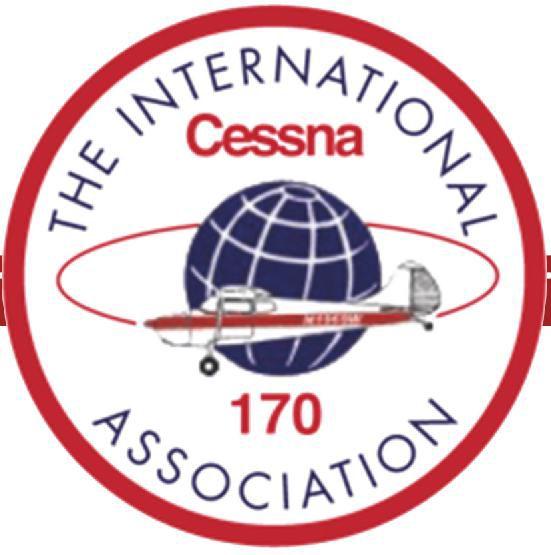
Reproduced with permission from The International Cessna 170 Association. Originally published at https://Cessna170.org/about/association-history.
THE BEGINNINGS OF WHAT became The International Cessna 170 Association started almost simultaneously in the minds of two pilots and 170 owners, one in Texas and the other in Iowa, in 1969. San Antonio, Texas, resident John Benham, interested in finding out about other 170 owners and organizing a fly-in, had letters posted in major aviation magazines requesting other owners send information about themselves and their airplanes. Bill Wehner, from Davenport, Iowa, frustrated with the prices of replacement cowl latches for his 170A, thought an organization of 170 owners would have some purchasing leverage that could alleviate some of the cost of
maintaining these older aircraft. He advertised in Trade-APlane for owners to join the National 170 Club for $3.50 a year. John and Bill quickly became aware of each other’s efforts. On April 15, 1969, John wrote a letter to the National 170 Club to inform Bill of the progress he had made. John had received 116 responses and had a proposal from 109 of them to have a three-day Cessna 170 fly-in in August at Cessna Field in Wichita, Kansas. Bill and John agreed to merge the two groups.
In August 1969, with the invitation of the Cessna Aircraft Co., John, Bill, and a total of 16 170 airplanes held the first national Cessna 170 fly-in in Wichita. A brand new type of airplane club organization was formed. After much discussion, it was agreed to call the new organization The
International Cessna 170 Association (TIC170A). The bylaws and constitution were worked out, intentionally designed not to be easily changed and not to be officially adopted for one year. The three stated goals of the association were as follows:
• To encourage, aid, and engage in the preservation, improvements, and better understanding of, the Cessna 170 aircraft.
• To foster, promote, and engage in aviation education.
The original goal was to collect and share information about safely flying and maintaining these classic airplanes, the oldest of which were built in 1948. This is still a prime function of the association today.
• To provide a source of information pertaining to the maintenance and operation of the 170.
Bill Wehner was the first president, serving for two years. John Benham would later serve as president from 1980 to 1982.
The second national convention, in 1970, was held in Colorado Springs, Colorado, and hosted by member John Collins. This started the tradition of volunteer convention hosts from the membership and the movement of the national fly-in to different areas of the United States and Canada each year. The ability to fly to and see the local sights all over the North American continent makes attending the annual 170 convention a unique fly-in and vacation experience.
The first 230 members who signed up at Colorado Springs were designated charter members with a C as part of their membership number. Membership is on an individual basis. However, the names of spouses are included in the membership database.

In the fall of 1970, an official logo designed by member Cleo Bickford was adopted. It features a red and white Cessna 170 circling a blue globe on a round white background with the association name in red inscribed inside a red circle. The registration number N1969W on the aircraft pictured does not reflect any actual aircraft. 1969 represents the year of the formation of the association, and the W is for Wichita.
In 1972 the association had grown so rapidly that an executive secretary was hired to manage the day-to-day details of membership and finance. A full board of directors was voted on by the membership, which includes a president, vice president, secretary/treasurer, historian, and past president, along with eight regular board members.
Annual conventions have continued since 1969, with the first convention held outside of the United States in Edmonton, Alberta, Canada, in 1977. The 2019 convention was a celebratory return of the membership to Newton, just north of Wichita, Kansas, for the 50th anniversary year of The International Cessna 170 Association. In the years since the founding, conventions have been held across the United States and Canada in small communities and large cities. Returning to earlier convention sites has only occurred twice for Lakeland, Florida, and San Diego, California.
From a handful who met over a weekend in 1969 in Wichita, the association membership
grew to a peak in 2001 of 1,620 members. For the last several years, membership has stabilized at around 1,000 members with more than 800 Cessna 170s. Area representatives of the association organize local and regional fly-ins and other get-togethers for members and guests.
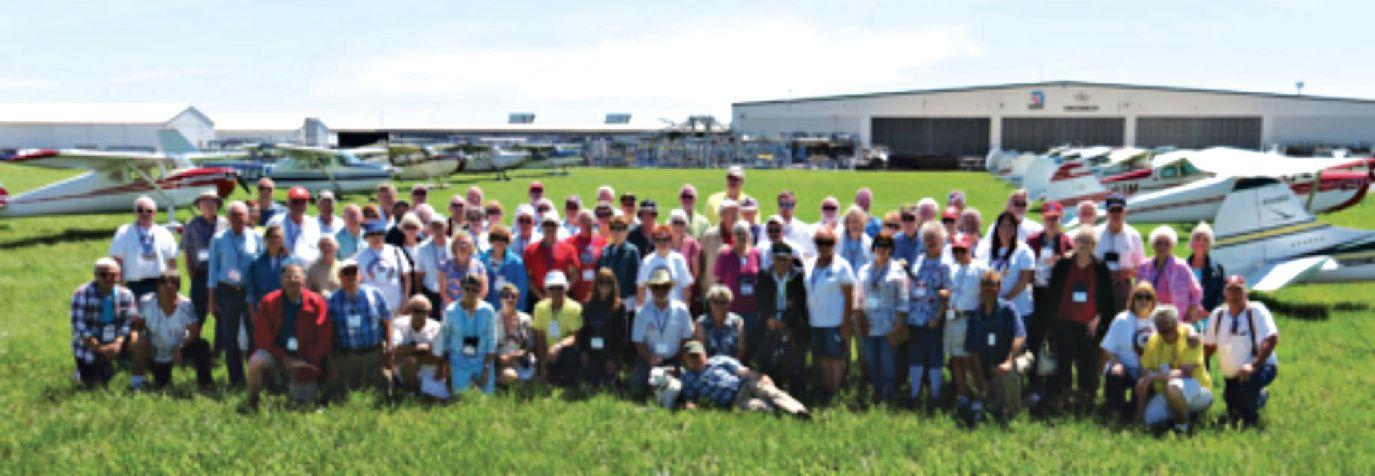
The original goal was to collect and share information about safely flying and maintaining these classic airplanes, the oldest of which were built in 1948. This is still a prime function of the association today: “To preserve and promote a truly classic aircraft.” The means for doing this starts with a vast resource of information on our forum, in our publications, and during sessions presented at conventions. But this association has become much more. This is truly a people-oriented organization enjoying fun, fellowship, and lifelong friendships with others around the world. We have members who have never owned a 170, or any airplane for that matter, who have become fixtures at many of the association’s activities. Lifelong friendships have formed, and different parts of the country have been visited, and that would never have happened outside of this association.
Anyone is welcome to join, regardless of the type of airplane you own or whether or not you even own an airplane. Visit https://Cessna170.org.
This is truly a people-oriented organization enjoying fun, fellowship, and lifelong friendships with others around the world.


MY GOOD PAL FRANK Rezich asked me to pen a column on the Bosch magneto that was used on the Navy Wright R-760-8 engines. Since I am familiar with the Bosch SB9RU magneto that was installed on the Pratt & Whitney R-985 engines, I thought it might be interesting to delve into history a little to find out just who Robert Bosch was and from where he came. So here it is — enjoy.
Bosch was born in Albeck, a village in southern Germany. He was the 11th of 12 children; his parents were from a class of well-suited farmers from the region. From 1868 to 1876 Bosch attended the Realschule, the secondary-technical school in the city of Ulm; then he took an apprenticeship as a precision mechanic. After his school and practical education, Bosch spent an additional seven years working at diverse companies in Germany and England, where he worked for Siemens Industries. While in the United States, Bosch worked at the lab of Thomas Edison.
On November 15, 1886, he opened his own Workshop for Precision Mechanics and Electrical Engineering in Stuttgart, Germany. A year later he made a decisive improvement to an unpatented magneto ignition device made by the engine manufacturer Deutz.
Nicolaus Otto (1832-1891) had invented the four-cycle internal combustion engine in 1848, and
with his partner Eugen Langden, Otto set up shop to market his invention. Otto’s technical advisor was a familiar name in the engine business, none other than Gottlieb Daimler. Daimler’s assistant was another talented inventor, Wilhelm Maybach. While Daimler wanted to utilize the newly invented four-stroke engine in an automobile, Otto was more interested in the manufacture of stationary engines. Daimler left the company in 1890, taking Maybach with him to form the Daimler Motoren-Gesellschaft to manufacture his designs (Figure 2). Eleven years later, Maybach designed the Mercedes automobile. A few years after that, Maybach left Daimler to set up his own factory to manufacture engines for Zeppelin airships.
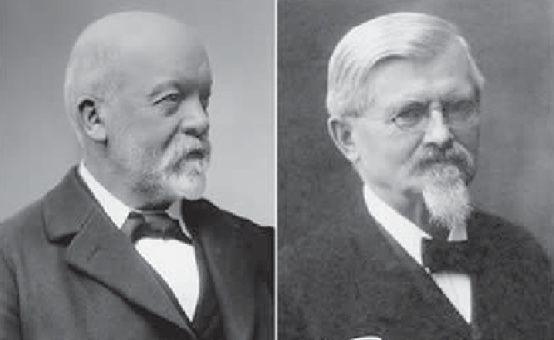
Otto’s internal combustion engine invention used a crude device to cause a spark that ignited a fuel/air charge inside the cylinder. It was this device that Bosch modified and perfected; work that would make him famous. The magneto refinement of Bosch and spark plug invention of Gottlob Honold made Otto’s internal combustion engine a product that would change the world. This gave Bosch his first business success. The purpose of the magneto device was to generate an electrical spark needed to cause the fuel/air mixture in a stationary combustion engine to explode. And in 1897 Bosch was the first person to adapt such a magneto ignition device to a motor vehicle engine. But only the invention of the first commercially viable high-voltage spark plug by Bosch’s engineer, Honold, in 1902 made possible the development of the internal combustion engine. With the invention of the high-tension spark plug, the Bosch magneto-spark plug combination became the standard for the automotive industry and was quickly adapted to the aviation world.
Even before the 19th century came to an end, Bosch had expanded his operations beyond Germany’s borders. The company established a sales office in the United Kingdom in 1898, and other European countries soon followed. The first sales office and the first factory in the United States were opened in 1906 and 1910, respectively. By 1913, the company had branch operations in the Americas, Asia, Africa, and Australia, and was generating 88 percent of its sales outside of Germany. In the 1920s the global economic crisis caused Bosch to begin a rigorous program of modernization and diversification in his company. In only a few years’ time he succeeded in turning his company from a small automotive supplier
founded on the skilled trades into a multinational electronics group. The face on the poster in Figure 3 became a Bosch regular, known as “Fritz the Flyer.”

Bosch opened a factory in the United States and manufactured magnetos under the name American Bosch (Figure 4). By 1920, the Bosch Company had sold more than a million magnetos. Bosch’s U.S. operation was taken over by the U.S. government’s Alien Property Custodian in 1918 as a consequence of the U. S. government’s declaration of war against Germany. After the war, Bosch re-entered the U.S. market under his own name and a 10-year legal battle ensued. In 1930 Bosch entered into an agreement with the U.S. Bosch Company, which would market the products of the German Bosch Company in the United States.
The Bosch magneto was manufactured for aircraft use in two distinct types: base-mounted, as used on the Pratt & Whitney engine, and flange-mounted, as used on the Wright engine. They were also produced in unshielded and shielded versions. Although heavy when compared to other Bendix and Scintilla magnetos, the Bosch product was very stout and quite reliable.

The Bosch SB9RU magneto as used on Pratt & Whitney R-985 radial engines is shown in Figure 5.

The series of photos in Figure 6, taken from a Pratt & Whitney overhaul manual, show the method of setting E-gap for the magneto (81). The center photo shows the method used to couple a magneto to an engine — a rubber disc with serrations that engage into drive on an accessory case (82). This type of magneto is base-mounted and requires some expertise to install. First the E-gap is set up by using a straight edge across the shaft to align with scribe marks on the case. It will be necessary to hold the shaft in this position so the E-gap will not change. Next the magneto is placed next to the engine drive, and the rubber coupler is moved until it lines up perfectly with the drive.
The magneto is then placed on the mounting pad, and a large drift is placed through one of the screw holes. An aft pull is exerted to compress the rubber drive and allow the magneto to slide down over dowel pins in the base. When this is completed, rotate the engine and check the point opening with piston location on the No. 1 cylinder. When the point opening coincides with the piston at 25 degrees BTC (before top center), insert the cap screws through the base and into the magneto. Complete the job by safety wiring the three screws together (83).
The sketches in Figure 7 show, using a Time Rite instrument, the proper method of setting the piston position in the No. 1 cylinder on compression stroke. The prop is turned in the direction of rotation until the beginning of compression is felt coming from the spark plug hole. Insert a Time Rite in the front spark plug hole (84). Align the cap of the indicator so that the slide slot lines up with the vertical axis of the cylinder. Push the slide pointer up close to the pivot arm (85). Turn the prop shaft in the direction of rotation until the pivot arm pushes the slide pointer to its farthest point (86). Turn the prop shaft about 90 degrees in the opposite
direction. This will return the pivot arm to the top of the slot. Adjust the proper engine scale (the scale numbered for R-985/R-1340) so that the 0-degree mark on the card aligns with the reference mark on the pointer (87).
Move the slide pointer up to align with the 25-degree mark on the card (88). Turn the prop shaft in the direction of rotation until the pivot arm just contacts the slide (89). At this point the piston in the No. 1 cylinder is now positioned 25 degrees before top center, and the magneto can be engaged to the drive on the accessory case. The two magnetos must synchronize; that is, both sets of points must open simultaneously so that the timing of the two magnetos is identical. A timing light must be used to assure proper synchronized timing of the magnetos to the engine.

The Time Rite instrument is a very handy device for setting the piston position in the No. 1 cylinder. I have used this device for my entire career as a mechanic.
During World War I, a group of engineers in Switzerland developed an outstanding magneto. After the war, a Chicago promoter, Laurence R. Wilder, obtained the American agency and brought the magneto to the United States in 1921. Scintilla was located in New York City at the time. Meanwhile, Sidney, New York, had recently lost its big manufacturer, the Hatfield Automobile Company, as it just couldn’t compete with Detroit. A former Hatfield official, Winfield Sherwood, volunteered without pay to search for a new industry for the village. Sherwood hit pay dirt in 1924, as he invited Scintilla officials to Sidney, convincing them to bring this superb magneto manufacturing line to the Tri-Towns. In 1925 the Scintilla Magneto Company bought the old Hatfield building and began manufacturing magnetos. By 1928, Scintilla had a much better factory and was purchased a year later by Bendix Aviation Corporation. Somehow, the company survived the Great Depression, and by 1939, it was filling orders for airplane magnetos for the Allies in Europe.
Scintilla produced magnetos for aircraft use, their coding being VMN, in both base- and flange-mount configurations. The magnetos were both unshielded and shielded. These magnetos were produced for many five- and seven-cylinder single-row radial engines. VMN-7D was a base-mounted unit, while the VMN7DF was a flange-mounted unit (Figure 8). Scintilla also produced a VMN7DFA magneto that had an automatic advance feature for easier starting. All magnetos of

this series were driven at 7/8-engine crankshaft speed.
The VMN7DF magneto was popular for installation on Continental W-670 and R-670 engines producing 220-hp. In 1929 the Bendix Aviation Corporation bought Scintilla Magneto Company, which became Scintilla Magneto Division, the manufacturing facility being retained in Sidney, New York. All subsequent magnetos were known as Bendix-Scintilla products.
Vincent Bendix (1881-1945) was an industrialist and inventor, and founder of the Bendix Corporation of Chicago in 1907 with the intent of manufacturing automobiles he called Bendix Buggies. After producing only 7,000 automobiles, the company failed in 1909, but Bendix went on to invent and patent the Bendix drive, a motor-driven gear that could engage an engine’s ring gear at low rotational speed and then fly back to disengage automatically at a higher speed. This drive made it possible for the installation of an electric starter on internal combustion engines for automobiles, aircraft, and other motorized vehicles. The Bendix drive is still in widespread use, so much so that mechanics often refer to the mechanism simply as a Bendix. Bendix founded the Bendix Brake Company in 1923 and started the Bendix Aviation Corporation in 1929. In 1930 Bendix invented the pressure carburetor. The corporation sponsored the Transcontinental Bendix Air Race in 1931. Bendix Aviation and Bendix Brake would later be renamed the Bendix Corporation.
The Bendix Corporation manufactured a competing magneto to the VMN model, known as the SF7 (Figure 9). It, too, was approved for several small radial engines but particularly was popular on the Continental W-670 and R-670 series. The SF7 was a flange-mounted unit and had the same tapered shaft dimensions as the VMN series. In order to fit the magnetos to different engines it was necessary to change the drive coupling.


The Bosch, Scintilla, and Bendix magnetos could be made to rotate either right-hand (clockwise) or lefthand (counterclockwise) simply by internal timing. The direction of rotation of magneto drives is determined by the engine manufacturer and is based on rotational direction of magneto drive gears in the accessory case. Drive direction of a magneto is determined by holding the magneto so as to view it from the
drive end. If the drive turns to the right, it is clockwise, and if the drive turns to the left, it is counterclockwise.
Both the Bendix and Scintilla magnetos adapted to shielded and unshielded harness assemblies. All the early installations were unshielded harness and spark plugs.

Let me just say that I enjoy some of the less complicated features of the 170. My point in this is that the Cessna 170 is one great airplane having evolved from the Cessna 120/140 and osmosing into the Cessna 172. For me, my all-time favorite airplane — the Cessna 180 Skywagon — serves as a complement to the Cessna 170. Over 5,000 Cessna 170s were manufactured starting in 1948 and ending in 1956. It is estimated that some number less than half of those 5,000-plus Cessna 170s are still in existence.
Another program for VAA at EAA AirVenture this year is no less exciting. We will be highlighting the Continental A40 engine with A40-powered aircraft as well as forums and displays of A40 memorabilia including a cutaway A40 engine. The Continental A40 engine was introduced in 1931 during the Great Depression. At that time, there was no small, reliable, and lightweight engine available to power airplanes. The introduction of this engine led to many aircraft designs that were affordable to pilots of average means, which eventually led to a large and vibrant aviation industry.
Fourteen A40-powered airplanes are scheduled to participate in the celebration at AirVenture 2023, with all but one flying into Wittman field. These airplanes will participate in flybys and in Ray Johnson’s Vintage in Review program, including engine runs. See you all at EAA AirVenture this summer. Blue skies!
COPYRIGHT © 2023 BY THE EAA VINTAGE AIRCRAFT ASSOCIATION.
VINTAGE AIRPLANE (USPS 062-750; ISSN 0091-6943) copyright © 2023 by the EAA Vintage Aircraft Association, Inc., is published bimonthly and owned exclusively by the EAA Vintage Aircraft Association, Inc., EAA Editorial Department, 3000 Poberezny Road, Oshkosh, WI, 54902. Periodicals postage is paid at Oshkosh, WI, 54901, and additional mailing offices. U.S. membership rate for the EAA Vintage Aircraft Association, Inc. is $45 per 12-month period for EAA members, and $55 for non-EAA members.
POSTMASTER: Send address changes to EAA MEMBERSHIP SERVICES, P.O. Box 3086, Oshkosh, WI 54903-3086. CPC 40612608
FOREIGN AND APO ADDRESSES: Please allow at least two months for delivery of VINTAGE AIRPLANE to foreign and APO addresses via surface mail.
ADVERTISING: Vintage Aircraft Association does not guarantee or endorse any product offered through the advertising. We invite constructive criticism and welcome any report of inferior merchandise obtained through our advertising so that corrective measures can be taken.
EDITORIAL POLICY: Members are encouraged to submit stories and photographs. Policy opinions expressed in articles are solely those of the authors. Responsibility for accuracy in reporting rests entirely with the contributor. No remuneration is made. Material should be sent to: Editor, VINTAGE AIRPLANE, PO Box 3086, Oshkosh, WI 54903-3086. Phone 920-426-4800
PRESIDENT Susan Dusenbury 1374 Brook Cove Rd. Walnut Cove, NC 27052 336-591-3931 sr6sue@aol.com
VICE PRESIDENT
Dan Knutson 106 Tena Marie Circle Lodi, WI 53555 608-354-6101 lodicub@charter.net
SECRETARY Dan Wood 75 Walton Place Dr. Newnan, GA 30263 678-458-3459 fly170@gmail.com
TREASURER Paul Kyle 1273 Troy Ct. Mason, OH 45040 262-844-3351 paul_e_kyle@hotmail.com
Jerry Brown Greenwood, IN 317-627-9428 lbrown4906@aol.com
George Daubner Oconomowoc, WI 262-560-1949 gdaubner@eaa.org
John Hofmann Columbus, WI 608-239-0903 john@cubclub.org
Ray L. Johnson Marion, IN 765-669-3544 rayjohnson@indy.rr.com
Steve Nesse Albert Lea, MN 507-383-2850 stnes2009@live.com
Earl Nicholas Libertyville, IL 847-367-9667 eman46@gmail.com
Joe Norris Oshkosh, WI 920-279-2855 wacoflyer@gmail.com
Tim Popp Sun City, AZ 269-760-1544 tlpopp@frontier.com
Charlie Waterhouse Dayton, OH 260-385-0851 charles.e.waterhouse@gmail.com
ADVISERS
Jesse Clement jesseclement1@gmail.com
Luke Lachendro avidaviator98@gmail.com
Kathy McGurran kmcgurran@aol.com
Kevin McKenzie kevinamckenzie@yahoo.com
Maxwell Wenglarz waco20900@gmail.com
David Bennett antiquer@inreach.com
Robert C. Brauer photopilot@aol.com
Dave Clark davecpd@att.net
Phil Coulson rcoulson516@cs.com
Ronald C. Fritz itzfray@gmail.com
Robert D. “Bob” Lumley rlumley1@wi.rr.com
Gene Morris genemorris@charter.net
ASSISTANT
Amy Lemke alemke@eaa.org
We will be highlighting the Continental A40 engine with A40-powered aircraft as well as forums and displays of A40 memorabilia including a cutaway A40 engine.
